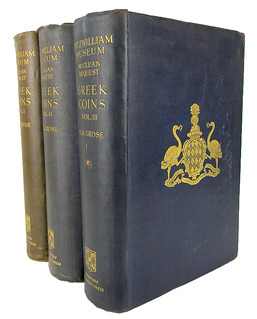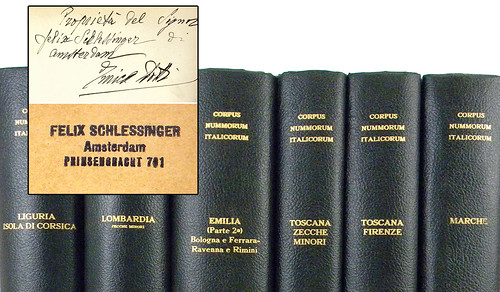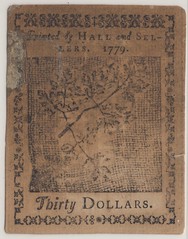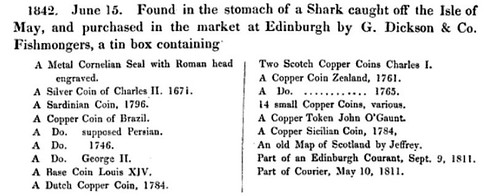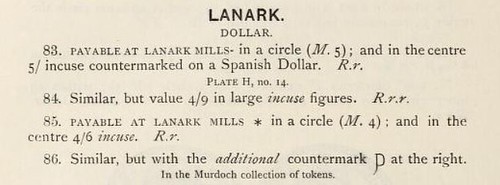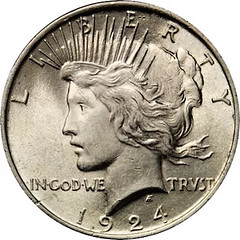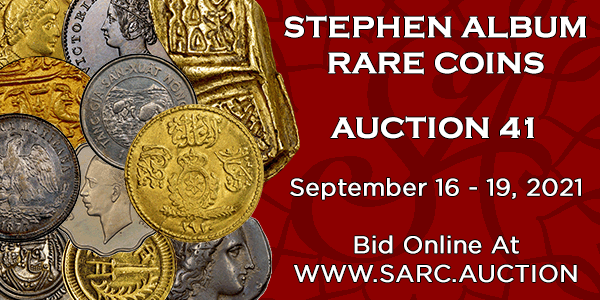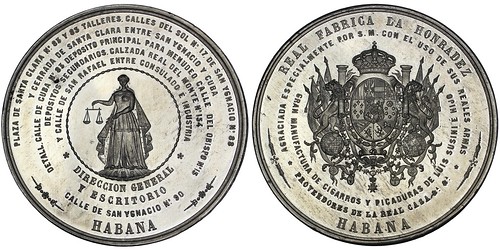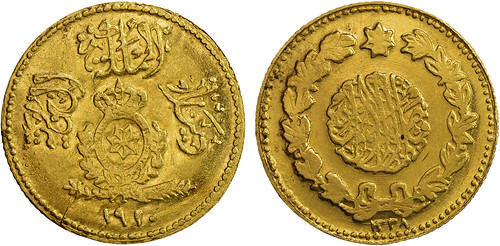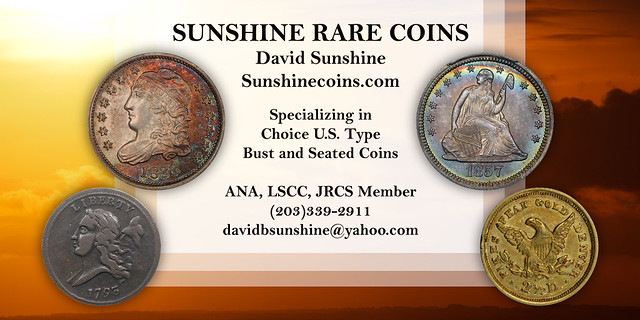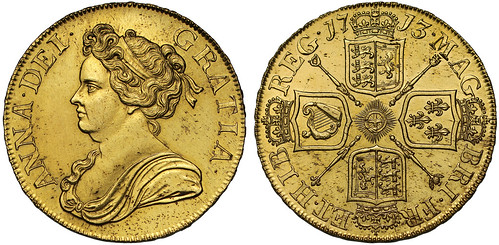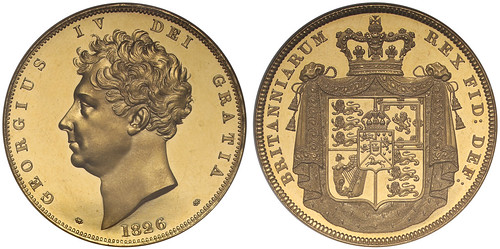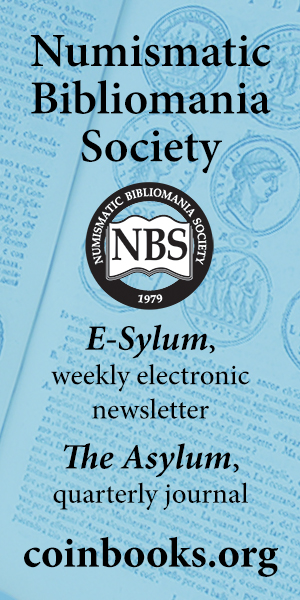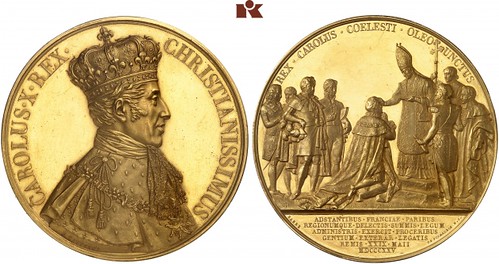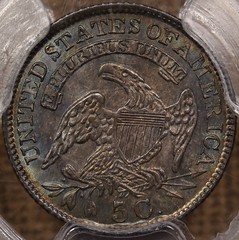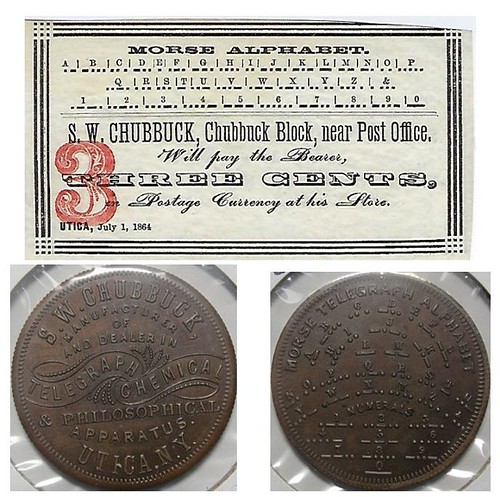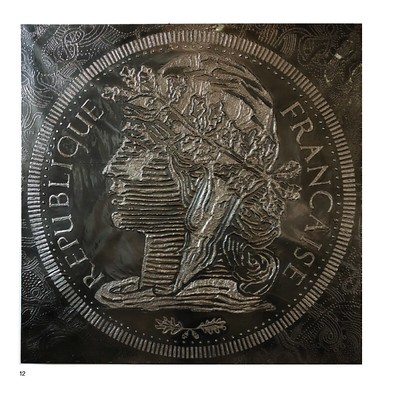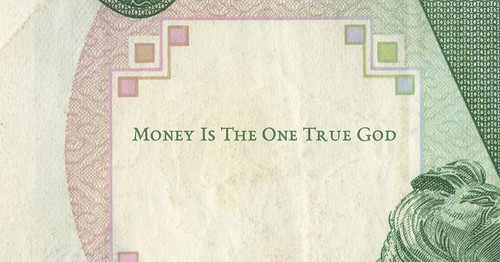
Visit our NBS Sponsors


About UsThe Numismatic Bibliomania Society is a non-profit association devoted to the study and enjoyment of numismatic literature. For more information please see our web site at coinbooks.org SubscriptionsThose wishing to become new E-Sylum subscribers (or wishing to Unsubscribe) can go to the following web page link MembershipThere is a membership application available on the web site Membership Application To join, print the application and return it with your check to the address printed on the application. Print/Digital membership is $40 to addresses in the U.S., and $60 elsewhere. A digital-only membership is available for $25. For those without web access, write to: Charles Heck, Treasurer AsylumFor Asylum mailing address changes and other membership questions, contact Chuck at this email address: treasurer@coinbooks.org SubmissionsTo submit items for publication in The E-Sylum, write to the Editor at this address: whomren@gmail.com BUY THE BOOK BEFORE THE COIN |
- WAYNE'S WORDS: THE E-SYLUM SEPTEMBER 5, 2021
- KOLBE & FANNING SALTON SALE HIGHLIGHTS
- NEW BOOK: OFFICIAL INAUGURAL MEDALS, 2ND ED.
- A CONTINENTAL DOLLAR TEST NOTE?
- VIDEO: ANTI-COUNTERFEITING FOUNDATION
- HOMREN NUMISMATIC POSTCARDS ON NNP
- MORE SHARK STOMACH COIN FINDS
- NOTES FROM E-SYLUM READERS: SEPTEMBER 5, 2021
- PROPOSAL: CADUCEUS COIN DESIGN
- QUERY: PEACE DOLLAR MODEL
- VOCABULARY TERM: FINISH AND FINISHING, PART 1
- EDWARD D. COGAN (1803-1884)
- COIN CARVER BLANCA DE LA HOZ
- CANADIAN COIN ARTIST SHEILA ORR
- COLLECTOR BUDDY EBSEN DANCES A JIG
- W.L. ORMSBY, PART THREE
- NUMISMAGRAM SELECTIONS: SEPTEMBER 2021
- STEPHEN ALBUM RARE COINS AUCTION 41
- SOVEREIGN RARITIES AUCTION 4 HIGHLIGHTS
- KUENKER AUCTION 352 SELECTIONS
- NUMISMATIC NUGGETS: SEPTEMBER 5, 2021
- THE CAPITAL COLLECTION OF MACERATED CURRENCY
- DETECTORIST FINDS GILDED FRENCH COIN BROOCH
- GOLD COINS FOUND IN FRENCH HOME RENOVATION
- NEW YORK'S FIRST CURRENCY
- S.W. CHUBBUCK AND THE BEETHOVEN EFFECT
- KA-CHING! THE ART OF ANN CARRINGTON
- VIDEO: MONEY IS THE ONE TRUE GOD
- SALES OF THE CURRENCY BY DAMIEN HIRST
- THE BIG BUSINESS OF LIBRARY E-BOOKS
- LOOSE CHANGE: SEPTEMBER 5, 2021
- FEATURED WEB SITE: HOMETOWN CURRENCY
Click here to read the thin version on the web
Click here to subscribe
Click here to access the complete archive
To comment or submit articles, reply to whomren@gmail.com
Content presented in The E-Sylum is not necessarily researched or independently fact-checked, and views expressed do not necessarily represent those of the Numismatic Bibliomania Society.
WAYNE'S WORDS: THE E-SYLUM SEPTEMBER 5, 2021
 We now have 6,679 subscribers.
We now have 6,679 subscribers.
Happy Anniversary, E-Sylum! We published our first issue 23 years ago yesterday, September 4, 1998. As it happened, that was the same day that Larry Page and Sergey Brin incorporated Google. Both events signaled a big change and two of the three of us got rich. All I got was a part time job, but it's been a fun ride. The E-Sylum has gotten bigger and better every year, and it's always fun to put together and work with this great numismatic community.
Thank you for reading The E-Sylum. If you enjoy it, please send me the email addresses of friends you think may enjoy it as well and I'll send them a subscription. Contact me at whomren@gmail.com anytime regarding your subscription, or questions, comments or suggestions about our content.
This week we open with Salton library highlights, one new book, updates from the Newman Numismatic Portal, a coin design idea, and more.
Other topics this week include a possible Continental Dollar test note, dealer Ed Cogan, collector Buddy Ebsen, coin artists Blanca de la Hoz and Sheila Orr, fixed price and auction highlights, cool coin finds, New York's first currency, and the money art of Ann Carrington and Damien Hirst.
To learn more about numismatic postcards, shark stomach coin finds, caduceus coins, W. L. Ormsby, the Chicago Motor Vehicle Company, Chinese block money and coin trees, macerated currency, the Chubbuck Telegraph Token and the Beethoven effect, read on. Have a great week, everyone!
Wayne Homren
Editor, The E-Sylum
KOLBE & FANNING SALTON SALE HIGHLIGHTS
Here are more highlights from the upcoming Kolbe & Fanning sale of the Salton library. -Editor
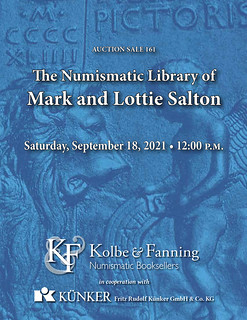 Kolbe & Fanning Numismatic Booksellers will be selling the outstanding library formed by Mark and Lottie Salton at auction on Saturday, September 18, 2021. Held in cooperation with Fritz Rudolf Künker, of Osnabrück, Germany, the 457-lot sale includes publications on ancient, medieval and modern coins from around the world, as well as important works on medals. The library’s holdings of European auction catalogues, many of which are heavily annotated, are among the most significant to be offered in many years.
Kolbe & Fanning Numismatic Booksellers will be selling the outstanding library formed by Mark and Lottie Salton at auction on Saturday, September 18, 2021. Held in cooperation with Fritz Rudolf Künker, of Osnabrück, Germany, the 457-lot sale includes publications on ancient, medieval and modern coins from around the world, as well as important works on medals. The library’s holdings of European auction catalogues, many of which are heavily annotated, are among the most significant to be offered in many years.
Some highlights of the sale include:
Lot 7: Max Bahrfeldt’s Nachträge und Berichtigungen zur Münzkunde der römischen Republik, one of the key publications on Roman Republican coins
Lot 52: Sidney W. Grose’s Catalogue of the McClean Collection of Greek Coins
Lot 105: an original set of Giulio Emanuele Rizzo’s magnificent Monete greche della Sicilia
Lot 162: Brause-Mansfeld’s classic work on siege money, in impressive armorial bindings
Lot 124: an exceptional set of the original editions of the SNG Copenhagen, complete in 43 fascicles, the first 38 of which are bound on hinges in half vellum
Lot 187: all five volumes of Georg Habich’s Die deutschen Schaumünzen des XVI. Jahrhunderts
Lot 255: Count Hutten-Czapski’s rare and wonderful work on Polish coins and medals
Lot 233: an original set of the Corpus Nummorum Italicorum, the massive 20-volume compendium spearheaded by King Victor Emmanuel III
Lot 399: the 1887 Rollin & Feuardent catalogue of the Vicomte de Ponton d’Amécourt’s collection of Roman and Byzantine gold coins
Lot 453: a complete set of Johann David Köhler’s Historischer Münz-Belustigung, an enormously influential early numismatic periodical.
To register for the sale online, bidders must go to bid.numislit.com and sign up through our Auction Mobility portal. You may then browse lots, place advance bids, or participate in the live sale online. Those wishing to participate on their devices can download the Kolbe & Fanning app through the Apple or Google Play Store. Traditional absentee bids may be placed via post, email, fax or phone. The sale is also available through Biddr, Sixbid and NumisBids.
The printed catalogue of the Salton Library has been mailed to all active customers on our mailing list. As international mail speeds have been slow in recent months, we encourage our international clients to consult the electronic catalogue in case their printed catalogue does not arrive promptly. A PDF of the printed catalogue has been posted to our main website at numislit.com for those who prefer that format. Bids placed via post, email, fax or phone must be received by September 17, the day before the sale, in order for them to be processed. Advance absentee bids may also be placed at any time online at bid.numislit.com. Live internet bidding will be available during the sale itself through the same platform.
Kolbe & Fanning Numismatic Booksellers LLC is a licensed and bonded auction firm in the State of Ohio. For more information, please see the Kolbe & Fanning website at numislit.com or email David Fanning at df@numislit.com. To register for the sale, go to bid.numislit.com. We look forward to your participation.
To read the earlier E-Sylum article, see:
KOLBE & FANNING SALTON LIBRARY SALE
(https://www.coinbooks.org/v24/esylum_v24n35a02.html)
NEW BOOK: OFFICIAL INAUGURAL MEDALS, 2ND ED.
A new edition of Matthew Chiarello's book on Inaugural Medals has just been published. He provided this overview. Thanks! -Editor
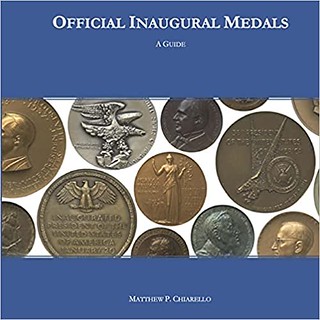 This time last year, I published a guide to official presidential inaugural medals. The original numbered hardcover edition is nearly sold out and features each of the medals through President Trump. A few months ago, I updated the guide in softcover to include the President Biden medal and a few other improvements. This is the first authoritative guide on the subject since the early 1980s.
This time last year, I published a guide to official presidential inaugural medals. The original numbered hardcover edition is nearly sold out and features each of the medals through President Trump. A few months ago, I updated the guide in softcover to include the President Biden medal and a few other improvements. This is the first authoritative guide on the subject since the early 1980s.
The book is a complete guide to official presidential and vice-presidential inaugural medals from William McKinley to Joe Biden. The updated and expanded version contains full-color images, along with a mintage and price guide for identifying medals and tracking collections. Limited hardcover first edition copies are available at Lori Ferber Presidential Collectibles. The softcover second edition is available on Amazon.
I was honored to be interviewed about the book on the Coin World Podcast (Episode #99, Hail to the Chief and to present on the medals at the Newman Numismatic Portal Symposium.
For more information, or to order the softcovered 2nd edition, see:
Official Inaugural Medals: A Guide Paperback
(https://www.amazon.com/Official-Inaugural-Medals-Matthew-Chiarello/dp/B08WK9TLY1/ref=sr_1_4)
To order the hardcovered first edition, see:
JUST RELEASED - Official Inaugural Medals - A Guide
(https://www.loriferber.com/official-inaugural-medals-book.html)
To read the earlier E-Sylum article, see:
NEW BOOK: OFFICIAL INAUGURAL MEDALS
(https://www.coinbooks.org/v24/esylum_v24n02a03.html)
To listen to the Coin World Podcast, see:
Hail to the Chief: Presidential Inaugural medals
(https://www.coinworld.com/news/precious-metals/cwpod_ep099)
To watch the NNP Symposium session, see:
From William to Joe: 120 Years of Official Presidential Inaugural Medals
(https://nnp.wustl.edu/library/book/598051)
A CONTINENTAL DOLLAR TEST NOTE?
The latest addition to the Newman Numismatic Portal is an image of what may (or may not) be a Continental Dollar Test Note. Project Coordinator Len Augsburger provided the following report. Thanks. -Editor
Newman Portal contributor Bruce Vogel forwarded images of this January 14, 1779 $30 Continental Currency note, along with the following story:
At the 1996 Denver ANA I met with Eric Newman at the base of an escalator. We spoke of several early Colonial & U.S. coin subjects. In 1990, Walter Breen had given me a chemistry textbook. As a page marker, Breen used a January 14, 1779 $30 note with no signatures or serial numbers. I knew what it was but asked EPN ‘What is this?’ Newman asked ‘Where did you get this? This is a test note, treat this as a test note.’ You probably knew Newman, his body language: as his left shoulder dropped & his head moved to the left & downward. ‘I wish I would have known about this, I have never seen one. Where?’ Me: ‘Breen used it as a bookmark.’ I was afraid I was going to have to pick Newman up off the floor. ‘He had it?’ That look of disbelief in his eyes. He asked for a photo, I said yes. I never sent one.
During the ANA convention, a noted authority on colonial paper viewed these images and wondered if in fact the signature had simply worn off the front of the note. The note currently resides in a PCGS About New 50 Apparent holder, with no mention of the test note attribution. We invite further discussion.
Link to NNP Edition of Early Paper Money of America:
https://nnp.wustl.edu/library/imagecollection/513468
VIDEO: ANTI-COUNTERFEITING FOUNDATION
These are selections from the David Lisot Video Library that feature news and personalities from the world of coin collecting. David has been attending coin conventions since 1972 and began videotaping in 1985. The Newman Numismatic Portal now lists all David’s videos on their website at:
https://nnp.wustl.edu/library/multimediadetail/522852
Here's one on the Anti-Counterfeiting Educational Foundation. -Editor
Anti-Counterfeiting Educational Foundation Helps Dealers at TNA Coin Convention 2021.
 June 5, 2021. Doug Davis, Director, Anti-Counterfeiting Educational Foundation, David Lisot, Interviewer, CoinTelevision.com.
June 5, 2021. Doug Davis, Director, Anti-Counterfeiting Educational Foundation, David Lisot, Interviewer, CoinTelevision.com.
Numismatics is being plagued by major counterfeiting problem. Dealers across America are having to cope with bogus coins many originating in China. The Anti-Counterfeiting Educational Foundation has a task force to help educate dealers about the problem. Doug Davis is Director of that organization and talks about his latest efforts to combat the problem.
An excerpt of the video is available for viewing on the Coin Television YouTube Channel at:
https://youtu.be/bEyN1g5HXDU
HOMREN NUMISMATIC POSTCARDS ON NNP
Another recent addition to the Newman Numismatic Portal is my collection of numismatic postcards. There are image galleries featuring cards issued by clubs, Stack's, other dealers, and individual collectors. Other galleries cover cards with images of U.S. Mints, Bureau of Engraving and Printing and the Treasury, plus a group of cards and correspondence of St. Louis dealer G. E. Sanguinetti, c. 1940.
The cards are mostly from the 1940s through the 1980s. Many came from the holdings of James O. Sloss of Beaver, PA. I bought his numismatic library after his passing.
Many thanks to NNP summer intern Garrett Ziss who imaged the collection of some 600 pieces and wrote up all the catalog data. That was a ton of work! Here are a few selections. -Editor
Dave Lange writes:
"That's a great collection---especially the coin dealer postcards. My favorites are the ones from Gimbels. I'm trying to acquire an imprinted catalog from each of the stores in the Minkus/Friedberg chain of coin and stamp franchises. I have 20+ of the 38 possible entries."
To view the postcard images, see:
https://nnp.wustl.edu/library/imagecollections?searchLetter=W
MORE SHARK STOMACH COIN FINDS
Julia Casey located a couple newspaper references to coins found in the stomachs of sharks. Cool. Thanks! -Editor
 I saw the message from David Powell about the Ramsgate token found in the stomach of the shark caught off Galveston in 1931. This is the AP story about it. This is from the Wilkes-Barre Record, Oct 10 1931 but I noticed it appearing in national papers as early as August 25, 1931.
I saw the message from David Powell about the Ramsgate token found in the stomach of the shark caught off Galveston in 1931. This is the AP story about it. This is from the Wilkes-Barre Record, Oct 10 1931 but I noticed it appearing in national papers as early as August 25, 1931.
When I went to Google to look around for more information on the story - this interesting mention popped up from A View of the Coinage of Scotland (John Lindsay, 1845). page 269.
Quite a little collection that shark-numismatist had! -Editor
To read the earlier E-Sylum article, see:
NOTES FROM E-SYLUM READERS: AUGUST 29, 2021 : More Stomach Coin Finds
(https://www.coinbooks.org/v24/esylum_v24n35a13.html)
NOTES FROM E-SYLUM READERS: SEPTEMBER 5, 2021
Numismatic Scrapbook and Coin World
 Coin World Managing Editor
Bill Gibbs writes:
Coin World Managing Editor
Bill Gibbs writes:
In reference to the following statement in last week’s E-Sylum, "The magazine Numismatic Scrapbook was published from 1935 to 1976 at Chicago by printer and collector Lee Hewitt (1911-1987), please remember that the predecessor to Amos Press, publisher of Coin World, acquired Numismatic Scrapbook from Hewitt in 1968 and published it in Sidney, Ohio, until its demise in 1976."
Correct. Thanks for the clarification. -Editor
To read the earlier E-Sylum article, see:
LOOSE CHANGE: AUGUST 29, 2021 : Revisiting 1974's Top Ten Ancients
(https://www.coinbooks.org/v24/esylum_v24n35a29.html)
Ellis 83 Should Be Davis 83
Regarding Eric Hodge's question about a countermarked dollar reference,
Julia Casey writes:
"If you look at the Zander correspondence the lot prior (#109) there is a reference made to "Ellis 38." This made me suspect that the "Ellis 83" in #110 may have been a typo. I was able to discover that W.J. Davis published The Nineteenth Century Token Coinage of Great Britain, Ireland, the Channel Islands, and the Isle of Man in 1904 and if you look at #83 it is a Lanark Mills counterstamped dollar! I think then that the reference should properly be "Davis 83."
To read the Davis entry, see:
https://archive.org/details/nineteenthcentur00davi/page/22/mode/2up?q=lanark
Bingo! Ron Haller-Williams agrees. He supplied an image of the coin from Plate H of the Davis book. -Editor
Eric Hodge writes:
"I think they are correct. Aren’t your readers wonderful?s Nothing seems too much to solve! Thank you. I can now sleep easier!"
To read the earlier E-Sylum article, see:
NOTES FROM E-SYLUM READERS: AUGUST 29, 2021 : Query: Ellis 83
(https://www.coinbooks.org/v24/esylum_v24n35a13.html)
A Muera Huerta 1 Peso Note
 Pablo Hoffman writes:
Pablo Hoffman writes:
"Here’s a rare and unrecorded 1-Peso note from the Mexican Revolution, not so-cordially wishing death upon the despised insurrectionist Victoriano Huerta. The traitorous Huerta connived, conspired, and murdered his way into the presidency of Mexico early in the tumultuous year of 1913. He managed to stay in office for eighteen months, until US President Woodrow Wilson intervened, tipping the political balance against him; Huerta then fled into exile in Spain."
Thanks! Great note. Emergency issues like this may be crude, but they are generally rare, interesting and historically important - just the stuff I love to collect. -Editor
To read the earlier E-Sylum article, see:
NOTES FROM E-SYLUM READERS: AUGUST 29, 2021 : Muera Huerta Paper Money
(https://www.coinbooks.org/v24/esylum_v24n35a13.html)
Operation Manna
Ron Haller-Williams writes:
 "It's a shame about the timing of Danny Shelton's request, because there was one on eBay, listed several times from mid June 2021, and it finally achieved the opening bid of £30 (about $40) on July 24, less than an hour before end of bidding.
"It's a shame about the timing of Danny Shelton's request, because there was one on eBay, listed several times from mid June 2021, and it finally achieved the opening bid of £30 (about $40) on July 24, less than an hour before end of bidding.
"Seems it exists in both silver and bronze. There are also some books, stamps, and first-day covers."
Thanks. Here are the links Ron provided. My recommendation would be to set up an eBay alert and wait for the next one to be offered. Alerts on auction-watch sites like Invaluable and Barnabys could help as well - sometimes things will show up in estate sales. -Editor
OPERATION MANNA 40TH ANNIVERSARY BRONZE MEDAL
(https://www.ebay.com/itm/274871076647)
An Operation Manna 40th Anniversary medallion, silver grade, with plastic case, a similar medallion, bronze grade,...
(https://www.tooveys.com/lots/262458/an-operation-manna-40th-anniversary-medallion/)
To read the earlier E-Sylum article, see:
NOTES FROM E-SYLUM READERS: AUGUST 29, 2021 : 1985 Operation Manna Commemorative Medal Sought
(https://www.coinbooks.org/v24/esylum_v24n35a13.html)
The Chase Manhattan Story of Money "Money Tree" Booklet
Regarding the booklet mentioned by Scott Barman,
American Numismatic Society Francis D. Campbell Librarian David Hill
writes:
"Here’s a scan of The Story of Money cover and title page. We have versions with copyright dates of 1962 (this one), 1966, and 1967."
Ron Haller-Williams also discovered several images of the booklet. Thanks! His web search was hampered by the fact the "The Story of Money" is a much-used title and subtitle, as seen in the book covers in the following image. -Editor
Ron adds:
"The "tree" is of 5 coins, but I believe from the shape that they are Japanese 100 Mon coins of c.1835."
Ron discovered that we'd actually illustrated this pamphet in a January 26, 2020 article. Thanks! Link below. I knew I'd seen it before. Ron wrote: "When I was about 10, a teacher said something about "a good forgettory". By now I'm very much aware of what he meant ... !!!" I like that. A good memory is great, but "a good forgettory" can actually be a good thing at times. Some memories I'd rather not recall, from accidents, illnesses, and slights from friends, to bad dates. -Editor
To read earlier E-Sylum articles, see:
THE CHASE MANHATTAN BANK MONEY MUSEUM
(https://www.coinbooks.org/esylum_v19n51a07.html)
NOTES FROM E-SYLUM READERS: JANUARY 26, 2020 : Chase Manhattan Bank Money Museum Pamphlet
(https://www.coinbooks.org/v23/esylum_v23n04a14.html)
NOTES FROM E-SYLUM READERS: AUGUST 29, 2021 : The Chase Manhattan Money Museum
(https://www.coinbooks.org/v24/esylum_v24n35a13.html)
Triple Book Covers
Speaking of similar numismatic book titles, there's also the issue of similar cover illustrations.
Ron Haller-Williams writes:
"Once (I can't remember when!) you pointed out two different books with the same cover illustration/painting."
Ron provided this trio of cover images. -Editor
It was Peter Jones who first pointed out the multiple use of "The Money-lender and his Wife", by Quentin Matsys c. 1514. Ron adds Pierre Vilar's 2011 third edition of A History of Gold and Money to the collection. Thanks! I guess I wouldn't be surprised if more examples turn up. -Editor
To read the earlier E-Sylum article, see:
NOTES FROM E-SYLUM READERS: AUGUST 8, 2021 : Seeing Double Book Covers
(https://www.coinbooks.org/v24/esylum_v24n32a15.html)
PROPOSAL: CADUCEUS COIN DESIGN
Wayne Pearson submitted this proposal for a new coin design incorporating a caduceus. Thanks. Interesting idea. -Editor
The hippocampus main functions in the brain involve human learning and memory. In addition to the name coming from the Greek words hippo and kampo, meaning horse, and monster, its' shape resembles a seahorse. The caduceus can represent commerce or medicine. On the Heritage Auctions site, Dave Bowers is quoted writing that Columbia's caduceus from the 1915 Panama Pacific two and a half dollar gold coin represents "the medical triumph over yellow fever in Panama during the canal construction."
Additional reading on the same site suggests it may very well represent the immeasurable impact the Panama Canal would have on international exchange. Instead of recognizing the Rod of Asclepius for a medical symbol, many seem to associate the caduceus with medicine instead. Older coins like this 1925 French two Francs show the caduceus representing commerce as referenced above.
Now that the history lesson is over, I've always liked the 1915 Panama Pacific two and a half dollar gold coin and have always thought it would make a nice coin design. Since our coins began using designs of liberty, in these days of trying times, it would be nice to see the hippocampus design used with Lady Liberty holding a caduceus.
To read the complete lot description, see:
1915-S 50C Five-Piece Panama-Pacific Set and Original Box
(https://coins.ha.com/itm/commemorative-gold/1915-s-50c-five-piece-panama-pacific-set-and-original-box-unc-details-through-ms65-pcgs/a/1234-4878.s)
QUERY: PEACE DOLLAR MODEL
Wayne Pearson submitted these images relating to the design of the Peace dollar. Thanks. -Editor
Here is a tracing of Teresa de Francisci, and a version of St. Gauden's Victory design.
Here are Teresa, the peace dollar design, and the St. Gauden's design modeled after Hettie Anderson. By looking at the forehead, nose, chin, lips and eye, who do you think the Peace dollar design resembles more?
I referred Wayne to Roger Burdette's research on the creation of the Peace dollar. -Editor
To read an earlier E-Sylum article, see:
NEW BOOK: A GUIDE BOOK OF PEACE DOLLARS BY ROGER BURDETTE
(https://www.coinbooks.org/esylum_v12n02a07.html)
VOCABULARY TERM: FINISH AND FINISHING, PART 1
Here's another entry from Dick Johnson's Encyclopedia of Coin and Medal Terminology. It's a biggie, so we'll split it in two parts. -Editor
Finish and Finishing. Any process that is performed to a medallic item (coins have no applied finish) after it is struck or cast; including antiquing, patinating, enameling, plating, fabricating, lacquering, edge stamping, mounting, other. At a plant that manufactures medals, other than the pressroom, the finishing department is the second largest department. Every struck piece, other than coin finish and proof surface, must pass through this finishing department for a number of processes to be applied to each piece, giving every medallic item its final color, appearance, protection and, often, its mounting.
The finishing department receives all the items in their final physical form, all the actions of the pressroom must be completed, all striking and trimming. The medals at this stage are called raw medals, they are completely struck up, all the design and all the lettering that is in the die or mold must be on every piece (some edgelettering or inscribing notwithstanding, these can be applied later). The finishing department must then perform their functions to transform those raw medals into works of medallic art with a most attractive surface that is to be protected for decades or centuries of their possible existence.
There is a very large metal finishing industry for processing most every manufactured metal object. However, the finishing procedures employed for medallic items have been adapted from this industry but occupy only a very small part of its technology, concentrating for the most part on finishes for bronze and silver objects.
Finishing department foreman. The foreman of the finishing department must be a craftsman with knowledge of metallurgy, chemistry, electrolysis and physics. He must be able to take a raw medal – fully struck up with every step of the pressroom completed – and transform that raw medal into a completed work of medallic art. He must have artistic knowledge as well and an aesthetic sense of what he is doing. He should be able to create any finish on a medal that he is called upon to produce (except, of course, coin finish or proof surface, neither of which receive any finishing).
The foreman must oversee every possible step of that medallic item through his department: its proper patina or other finish, its enameling (in proper color, if required), its electroplating (as goldplating or silverplating, if necessary), its fabrication (bringing several parts together if needed), its lacquering (for almost every piece) and complete the item with its suspension or mounting. Then pass this completed medallic masterpiece on to inspectors who will search for any misdeed of his department or imperfection of the piece before it is approved, packaged and prepared for shipment.
First step: abrasive blasting. The usual first step for most every item in the finishing department is to abrasive blast the raw medal. This creates a roughness on the surface, microscopic craters, called cups, cover the entire surface. They are called cups because they can hold liquid. A number of the steps to follow will use liquid to color, to antique, or patina the metal surface.
The abrasive can be any of several kinds, sand, pumice or glass beads. Originally a fine grain sand was used and the process was called sandblasting. Modern technology is able to create glass beads in an even finer grit, so this abrasive has replaced sand. Medals are laid flat on a large rotating tray within an enclosed hood. Nozzles pelt the exposed surface of the medals with the abrasive under pressure.
Impacting the medal's surface with thousands of microscopic cups per square inch, the abrasive breaks up the smooth surface created by the die in the pressroom. The tiny grains fall off the medal and pass through holes in the rotating tray to a receptacle below where the abrasive is recycled to be used again by the nozzles above. All effort is made to contain the abrasive within the confines of the machine as it is used over again.
The color of the medals change most dramatically in this step. Raw medals are usually bright: bronze is usually bright red like a shinny penny, silver a light reflective gray. The abrasive is usually matte gray, and the surface of the medals take on this matte gray appearance. The pelting affects only the exposed side only, so the medals have to be turned over by hand and allowed to rotate under the nozzles for the opposite side to be abrasive blasted as well. It is not necessary to sandblast the edge, even on a thick medal.
The treated medals are picked out by hand, the excess abrasive is shaken off, then placed in wire baskets, perhaps a dozen at a time. The medals are placed vertically in a long handle wire basket in such a way that both sides are exposed. The medals are prepared now for either an antique finish (by oxidation and relieving), or a patina finish. The surface is now suitable for treating with a liquid (in the microscopic cups).
To read the complete entry on the Newman Numismatic Portal, see:
Finish and Finishing
(https://nnp.wustl.edu/library/dictionarydetail/515913)
EDWARD D. COGAN (1803-1884)
American Numismatic Biographies author Pete Smith submitted this item on early dealer Ed Cogan. Thanks! -Editor
 Cogan, Edward D(avid) Dealer and Cataloger (b. 1/5/1803 d. 4/7/1884)
Cogan, Edward D(avid) Dealer and Cataloger (b. 1/5/1803 d. 4/7/1884)
Born at Higham Hill, Walthamstow, Essex County, England. He emigrated to the U. S. in 1853. He was married to Louise Webb. They had eight children including George W. Cogan. Employed as a picture dealer in Philadelphia.
Cogan began in the coin business in Philadelphia in 1856. He conducted an auction of cents in 1858. The 77 lots realized $128.63. The sale was conducted through the mail, but a catalog was not printed until some time after the sale.
He issued store cards in 1859 and 1860. Moved to Brooklyn, New York, in March 1867. He conducted 69 auction sales 1858 to 1879. The Mortimer MacKenzie catalogue for the sale of June 23, 1869 was the first American auction catalogue with photographic plates. Published Table of Gold, Silver and Copper Coins, Not Issued by the United States Mint. He died in Brooklyn.
Cogan is called "the father of U. S. coin collecting" or alternately "the father of the coin trade in America." He was made an honorary member of the ANS.
To read earlier E-Sylum articles, see:
COGAN COIN THEFT BROADSIDE
(https://www.coinbooks.org/esylum_v03n51a16.html)
To read earlier E-Sylum articles, see:
EDWARD DAVID COGAN (1803-1884)
(https://www.coinbooks.org/esylum_v19n16a10.html)
NEWMAN PORTAL SCANS EDWARD COGAN CATALOG SET
(https://www.coinbooks.org/esylum_v19n17a08.html)
COIN CARVER BLANCA DE LA HOZ
With permission we're publishing this excerpt from Carol Bastable's article in the Fall 2021 issue of Bo Tales from the Original Hobo Nickel Society, Inc. Thanks! It's a profile of carver Blanca de la Hoz of Spain. -Editor
 In 2012 Blanca de la Hoz found her way to hobo
nickels through her husband, Pedro Villarrubia.
Some members may remember meeting Pedro at the
2013 FUN show or reading about him in the
following Spring issue. Blanca and Pedro reside in
Spain, not too far from the capitol city of Madrid but
far enough away that it would be termed country
living. Seeing Pedro make his hobo nickels piqued
Blanca’s curiosity and within a few months she was
behind the graver herself. Pedro has been her sole instructor in
learning how to carve and engrave.
In 2012 Blanca de la Hoz found her way to hobo
nickels through her husband, Pedro Villarrubia.
Some members may remember meeting Pedro at the
2013 FUN show or reading about him in the
following Spring issue. Blanca and Pedro reside in
Spain, not too far from the capitol city of Madrid but
far enough away that it would be termed country
living. Seeing Pedro make his hobo nickels piqued
Blanca’s curiosity and within a few months she was
behind the graver herself. Pedro has been her sole instructor in
learning how to carve and engrave.
The couple has two daughters that also have some interest in the art form. The daughters have on occasion tried to engrave hobo nickels and enjoyed it. At the moment they are busy with studies and focused on their schooling. Blanca said that in the future they will probably want to get more involved with hobo nickels. It is truly a family affair.
Art has always been of interest to Blanca. Since she was little she has always liked drawing and painting. She has worked with watercolor, acrylic, and pastel painting and enjoyed learning the techniques specific to each medium. Blanca has also enjoyed working within different craft mediums such as ceramic and embossed tin. Now her work with coin carving has taken center stage.
One of the things Blanca likes about hobo nickels is that she can work from home and help provide for her family while still being there to take care of them. It also gives her a good deal of flexibility with work hours. Working side by side with her husband, Pedro, has also been a perk. A year after Pedro’s trip to the United States in 2013, he returned again to buy a Lindsay graver system for his wife Blanca. For over a year they were sharing one system and scheduled work hours around each other. Now they do not have to rotate their studio time. They also each have their own microscopes to work under.
Blanca engraves a variety of subjects but likes mythological entities best. Fairies, mermaids, and undersea worlds are favorites. She also likes subjects from fanciful stories and draws subjects from Disney and Star Wars. Blanca’s work has gotten very elaborate through the years with current work often using many metal inlays. The different colors seem to add a fantasy or storybook world to the engravings much like the colored cells used in Disney movies.
For more information on the Original Hobo Nickel Society, see:
http://www.hobonickels.org/
CANADIAN COIN ARTIST SHEILA ORR
This CBC News article interviews the Cree artist who designed a new gold coin for the Royal Canadian Mint. Here's an excerpt - see the complete article online. Orr's design shows a Cree family leaving their camp to take their pelts to the Hudson's Bay Company trading post. Thanks to Dick Hanscom for passing this along. -Editor
 A James Bay Cree artist living in northern Saskatchewan says the gold coin she designed for the Royal Canadian Mint is a tribute to her people and the important role they played during the fur trade.
A James Bay Cree artist living in northern Saskatchewan says the gold coin she designed for the Royal Canadian Mint is a tribute to her people and the important role they played during the fur trade.
Sheila Orr, who grew up in Chisasibi, Que., about 1,700 kilometres north of Montreal, designed a collector gold coin for the Royal Canadian Mint. It's the fourth in a series called Early Canadian History.
"I was very humbled. I was very honoured to be asked to do this," said Orr, who left Quebec in the 1980s to study art and then teach fine arts at the Saskatchewan Indian Federated College in Regina. The college is now the First Nations University of Canada at the University of Regina.
Orr, who is of Cree, Inuit and Scottish heritage, currently lives in northern Saskatchewan and says she longs to return to Eeyou Istchee, the traditional name of the Cree territory in Quebec.
Quebec Cree trappers played a pivotal role in the early fur trade in Canada. It was on Sept. 29, 1668, when the Hudson Bay Company ship called the Nonsuch anchored off the mouth of the Rupert River, near present day Waskaganish, another Cree community along James Bay.
The following spring, according to Hudson Bay Company archives, Cree hunters came and traded beaver pelts with the crew.
It was the first successful trading voyage.
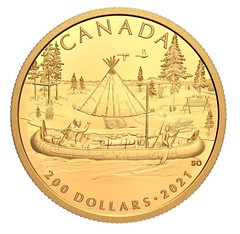 The coin Orr designed depicts the fur trade in the mid-1700s from a Cree perspective. It shows a family departing from their camp during springtime, their canoe loaded with supplies for their trip to the trading post. The adults are wearing caribou coats and the child is dressed in a rabbit fur coat, traditional clothing worn by the Cree. On the land the fish are drying, the geese are flying and beaver skulls are hung in the trees, in thanks for a harvest.
The coin Orr designed depicts the fur trade in the mid-1700s from a Cree perspective. It shows a family departing from their camp during springtime, their canoe loaded with supplies for their trip to the trading post. The adults are wearing caribou coats and the child is dressed in a rabbit fur coat, traditional clothing worn by the Cree. On the land the fish are drying, the geese are flying and beaver skulls are hung in the trees, in thanks for a harvest.
"In my mind I imagined what we dressed like and what we wore," said Orr, who also drew on stories of her mom and her grandmother. Orr submitted three drawings and spent several months revising the chosen image. The mint also consulted with the Chisasibi elders council.
To read the complete article, see:
New gold collector coin depicts fur trade from Cree perspective
(https://www.cbc.ca/news/canada/north/cree-coin-canadian-mint-currency-fur-trade-contact-history-1.6162518)
THE BOOK BAZARRE
COLLECTOR BUDDY EBSEN DANCES A JIG
Over on the NGC site, Jim Bisognani wrote a tribute to his friend Keith Zaner. See the complete story online, but I wanted to excerpt this part about "Beverly Hillbillies" and "Barnaby Jones" actor Buddy Ebsen's collection. Ebsen was an old vaudeville and movie song and dance man before hopping to the small screen. -Editor
Although we didn’t socialize much outside the office, we did get to know what made each of us tick. We discussed our favorite numismatic icons (Keith’s was the 1822 Half Eagle), how we both got started with coins and the auction sales we had attended. I fondly recall Keith’s favorite sale. It was a Superior Galleries Auction sale, held at the Century Plaza Hotel May 31-June 2, 1987, and the headline collection was that of actor Buddy Ebsen (from the Beverly Hillbillies show).
Ebsen was quite the serious collector. He even co-founded the Beverly Hills Coin Club and had amassed a significant numismatic cabinet. Keith, who was attending for Coin World as the Trends editor, described how after each coin brought a higher price than expected, or just for sheer joy, Mr. Ebsen would get up and break out a few dance moves to raucous applause and appreciation of those present. Keith said, I had to get Buddy to sign the auction catalog for me.
The image of Buddy Ebsen doing a little jig after some especially pleasing auction results stays with me to this day. I relayed to Keith that just a few months after that sale, I attended my first Long Beach Expo in the fall of 1987, and I picked up an early Half Eagle from the Ebsen collection. (I wish I still had it.) Keith said, Hey, I was there, too. We could have run into each other.
Were any of our readers there for the sale? -Editor
To watch Buddy bust a move, see:
Buddy Ebsen on Broadway
(https://www.youtube.com/watch?v=4U8l-drqj1E)
Buddy Ebsen dancing 1978
(https://www.youtube.com/watch?v=G2cc9g8DMFU)
To read the complete article, see:
Jim Bisognani: A Truly One of a Kind Friend
(https://www.ngccoin.com/news/article/9404/Weekly-Market-Report-September-9-2021/)
To read the earlier E-Sylum article, see:
COIN WORLD TRENDS EDITOR KEITH ZANER
(https://www.coinbooks.org/v24/esylum_v24n32a09.html)
W.L. ORMSBY, PART THREE
Susan Bremer of Heritage published the last of a series of articles about engraver, author and publisher W.L. Ormsby. It appeared in the September 1, 2021 issue of the Heritage Currency News email. -Editor
 In this final foray into the fascinating legacy of W.L. Ormsby, we will take a deeper look at his writings, and their role in his professional downfall. Part I and II of this series introduced W.L. Ormsby, his inventions, engravings, and some of his writings. All were in service to his passionate interest in banknote engraving and its improvement to deter counterfeiting. Ormsby's dedication to the issue of counterfeiting during the 1850s-60s was unrelenting. His brash writings spurred scandal and contributed to his lasting legacy as an accused counterfeiter.
In this final foray into the fascinating legacy of W.L. Ormsby, we will take a deeper look at his writings, and their role in his professional downfall. Part I and II of this series introduced W.L. Ormsby, his inventions, engravings, and some of his writings. All were in service to his passionate interest in banknote engraving and its improvement to deter counterfeiting. Ormsby's dedication to the issue of counterfeiting during the 1850s-60s was unrelenting. His brash writings spurred scandal and contributed to his lasting legacy as an accused counterfeiter.
A prolific author, Ormsby wrote multiple texts on anti-counterfeiting. His first volume, A Description of the Present System of Banknote Engraving, was published in 1852. This book detailed the many contributing factors that permitted the preponderance of counterfeiting occurring at that time. After the publication of this book, rather than being met with thanks and congratulations, Ormsby, to his own great surprise, became the subject of journalistic criticism and allegations of counterfeiting. The public generally ignored these rumors for a number of years, but that all changed in March 1858.
In this final foray into the fascinating legacy of W.L. Ormsby, we will take a deeper look at his writings, and their role in his professional downfall. Part I and II of this series introduced W.L. Ormsby, his inventions, engravings, and some of his writings. All were in service to his passionate interest in banknote engraving and its improvement to deter counterfeiting. Ormsby's dedication to the issue of counterfeiting during the 1850s-60s was unrelenting. His brash writings spurred scandal and contributed to his lasting legacy as an accused counterfeiter.
A prolific author, Ormsby wrote multiple texts on anti-counterfeiting. His first volume, A Description of the Present System of Banknote Engraving, was published in 1852. This book detailed the many contributing factors that permitted the preponderance of counterfeiting occurring at that time. After the publication of this book, rather than being met with thanks and congratulations, Ormsby, to his own great surprise, became the subject of journalistic criticism and allegations of counterfeiting. The public generally ignored these rumors for a number of years, but that all changed in March 1858.
 Ormsby published an inflammatory pamphlet in 1857 entitled The Administration of the Bank Department of the State of New York on the Subject of Bank Note Engraving containing details of my correspondence and experience with various Superintendents and a variety of valuable information on the subject of the prevention of counterfeiting. The pamphlet included a reprint of Ormsby's article from the New York Herald Bogus Bank Bills-History of Counterfeiting-Its Remedy. Direct criticism of many of the superintendents in the New York banking industry was evident throughout the pamphlet, most especially Superintendent Marius Schoonmaker. Testimonials from notable individuals who believed in Ormsby's innocence, such as Samuel Morse, were also included. The testimonials were counteracted by the pamphlet's other foolhardy contents. Most importantly, this scandalous pamphlet demonstrated, from Ormsby's instructions to a known counterfeiter, John Dye, the ease of counterfeiting banknotes. To be clear, Ormsby included in this pamphlet, an illustration of a counterfeit note created by Mr. Dye made by following directions given to him by Ormsby himself. Ormsby's misguided attempt to bring attention to the problematic ease of counterfeiting contemporary currency had a decidedly negative impact on his reputation.
Ormsby published an inflammatory pamphlet in 1857 entitled The Administration of the Bank Department of the State of New York on the Subject of Bank Note Engraving containing details of my correspondence and experience with various Superintendents and a variety of valuable information on the subject of the prevention of counterfeiting. The pamphlet included a reprint of Ormsby's article from the New York Herald Bogus Bank Bills-History of Counterfeiting-Its Remedy. Direct criticism of many of the superintendents in the New York banking industry was evident throughout the pamphlet, most especially Superintendent Marius Schoonmaker. Testimonials from notable individuals who believed in Ormsby's innocence, such as Samuel Morse, were also included. The testimonials were counteracted by the pamphlet's other foolhardy contents. Most importantly, this scandalous pamphlet demonstrated, from Ormsby's instructions to a known counterfeiter, John Dye, the ease of counterfeiting banknotes. To be clear, Ormsby included in this pamphlet, an illustration of a counterfeit note created by Mr. Dye made by following directions given to him by Ormsby himself. Ormsby's misguided attempt to bring attention to the problematic ease of counterfeiting contemporary currency had a decidedly negative impact on his reputation.
Accusations and rumors continued to plague Ormsby. In March 1858, Ormsby filed a suit against Benjamin Douglas, the proprietor of the Merchantile Agency in New York City for public and malicious slander for $10,000 in damages. The case was founded upon Douglas having told a group of New York businessmen that Ormsby would engrave plates for anyone, without thought or question to the client. During the case, Douglas's attorneys asserted that Ormsby had counterfeited notes for eight different banks and engraved labels for fraudulent medical products. However, when pressed, Douglas's attorneys were unable to provide corroborating evidence. Despite this, the judge ruled against Ormsby, stating that the slander was committed privately and therefore was not public or malicious. The judicial decision was upheld during Ormsby's appeal.
His final work, Cycloidal Configurations, or the Harvest of Counterfeiters, was published in 1862. Ormsby used a fair portion of this work as a personal diatribe, casting blame on other banknote companies for the rumors and allegations circulating against him: "...when the Banknote Companies saw how the proposed reform would diminish their profits, it became a business to malign me. But, in the ten years struggle that ensued, every Bank Note Company perished or was absorbed in one establishment. Mine alone remained, and I still remain, the sole representative working engraver, at the head of a Bank Note Establishment, in the entire country..."
Despite the distraction of this personal digression, Cycloidal Configurations, or the Harvest of Counterfeiters remains important, as it introduced Ormsby's best anti-counterfeiting tool - the Furioso notes, which are single-plate engraved notes. (An example of this type is shown [above]) While potentially an effective counterfeiting deterrent, this idea never gained any traction with US Treasury Department, perhaps due to the time and expense involved, or perhaps simply because it sprang from poorly regarded Mr. Ormsby. Cycloidal Configurations details at length the Treasury Department's many failures both to recognize and support his attempts to help and improve the system as well as to ensure that US banknotes were difficult to counterfeit. Ormsby strongly believed that the patchwork system in use for currency could be easily counterfeited.
Salmon P. Chase and Spencer Clark, at the Treasury Department, particularly impacted Ormsby's career. Spencer Clark was designated to design the National Currency, introduced in 1863. He chose to adopt the methods defined in Ormsby's first volume, A Description of the Present System of Banknote Engraving, published 11 years earlier. Salmon P. Chase believed that ideas were Clark's and approved the adoption of these methods as well. Unfortunately, due to Clark's ineffective communication with the banknote companies, the only note that closely follows Ormsby's recommendations is the $5. The other National Currency notes were created in the patchwork system. Secretary Chase refused to let the Continental Bank Note Company have anything to do with National Currency, likely because of Ormsby's public reputation. A letter from Ormsby to Salmon P. Chase in 1867 places the blame for Ormsby's forced retirement and loss of career on Chase's actions. In 1870, a letter from Ormsby to Hon. Geo. S. Boutwell details the use of Ormsby's book by Clark, the Continental Bank Note Company's loss of revenue as consequent to Chase's decision, the company's eventual takeover from co-founder Touro Robertson, and another dogged offer of aid to the Treasury Department. Sadly, yet unsurprisingly, the Treasury Department never gave Ormsby the opportunity to join its forces. Ormsby spent his retirement on a farm in Hampton, Connecticut, initially purchased for his mother. He passed away in 1883 at the age of 74.
W.L. Ormsby's unflagging passion for anti-counterfeiting is well documented. He spent most of his years designing more effective anti-counterfeiting tools and fighting to persuade the banking industry and government to use them. Best remembered as an accused counterfeiter, Ormsby's contributions through writing, invention, and engraving brought important advancements to the banknote industry. His life's story is one that few will forget.
To read the earlier E-Sylum article, see:
W.L. ORMSBY, PART ONE
(https://www.coinbooks.org/v24/esylum_v24n25a17.html)
W.L. ORMSBY, PART TWO
(https://www.coinbooks.org/v24/esylum_v24n30a16.html)
FURIOSO PLATES, W.L. ORMSBY, AND BANKNOTE FRAUDS
(https://www.coinbooks.org/esylum_v19n45a05.html)
NUMISMAGRAM SELECTIONS: SEPTEMBER 2021
Jeremy Bostwick at Numismagram forwarded these highlights from his most recent upload of medallic art to his website. In addition to his usual selection of world art medals and plaques, there are four Russian icons that continue in the vein of attractive and artistic pieces–one of which is included in the highlights below. For all of his new items, please visit numismagram.com/inventory. -Editor
101766 | CUBA. Honradez Royal Tobacco Factory tin Medal. Issued circa 1859 (57mm, 87.60 g, 12h). PLAZA DE SANTA CLARA No 83 Y 85 TALLERES, CALLES DEL SOL No 17, DE SAN YGNACIO No 88 / Y CERRADA DE SANTA CLARA ENTRE SAN YGNACIO Y CUBA / DETALL, CALLE DE CUBA No 83 DE POSITO PRINCIPAL PARA MENUDEO CALLE DEL OBISPO No 15 / DEPOSITOS SECUNDARIOS, CALZADA REAL DEL MONTE No 154 / Y CALLE DE SAN RAFAEL ENTRE CONSULADO É INDUSTRIA / DIRECCION GENERAL / Y ESCRITORIO / CALLE DE SAN YGNACIO No 90 / HABANA, female personification of Justice standing facing, holding scales / REAL FABRICA LA HONRADEZ / AGRACIADA ESPECIALMENTE POR S. M. CON EL USO DE SUS REALES ARMAS / GRAN MANUFACTURA DE CIGARROS Y PICADURAS DE LUIS SUSINI É HIJO / PROVEEDORES DE LA REAL CASA &a. &a. / HABANA, complex Cuban coat-of-arms. Edge: Plain. Choice Mint State. Highly brilliant and reflective, with just a few lightly scattered marks preventing gem status. $295.
Cuban cigars have long been the standard bearer of a fine tobacco product, and Don Luis Susini's royal factory in Havana sought to keep that high standard through not just the firm's name (la honradez meaning "honesty" or "integrity"), but also through what was, at the time, revolutionary packaging.Counterfeiting was commonplace and copyright protection was virtually non-existent, so Susini turned to packaging in order differentiate himself from fraudulent products, with the firm using color lithography to produce some of the world's first colored labels.
A wordy yet intricate design. -Editor
To read the complete item description, see:
101766 | CUBA. Honradez Royal Tobacco Factory tin Medal.
(https://www.numismagram.com/product-page/101766)
101778 | GREAT BRITAIN. Middlesex Spence's Copper Halfpenny Token. Issued 1795 (29mm, 12.14 g, 6h). A MILLION HOGG | A GUINEA • PIG / ODD * FELLOWS *, janiform head composed of King George III and an ass / TREE OF LIBERTY, four men clasping hands and dancing around pike surmounted by head of George III; branch to left and right, two cornuacopiae below. Edge: Plain. D&H 797a. Choice Mint State. Charming chocolate brown surfaces, with some alluring brilliance remaining. A popular and highly provocative satirical type. $345.
This type plays upon sentiments of the time–mostly revolving around the French Revolution, the rise of Napoleon, and Britain's increased spending to form a European coalition to fight back the eventual dictator. The head of the king is obvious, and does not downplay his rotund features, while the head of the ass is more indirect. It can be seen as William Pitt the Younger, Prime Minister and the one calling for the increased taxation to fight against Napoleon. The ass can also be interpreted as the British citizenry itself, as it was they, through parliament, that caused Pitt to be in that position. The "million hogg" was to point fun at the king, for his allowance of seemingly everything to be taxed, while the "guinea pig" was a pointed allusion to one such tax—the "hair powder tax." A tax of one guinea per year was applied to hair powder for wigs, with those initially agreeing to such a tax being the guinea pigs. Meanwhile, the reverse alludes to the beheadings in France, with Britain's own monarch drawing the ire of the token maker instead.
A classic piece. -Editor
To read the complete item description, see:
101778 | GREAT BRITAIN. Middlesex. Spence's Copper Halfpenny Token.
(https://www.numismagram.com/product-page/101778)
101751 | UNITED STATES. Chicago, Illinois. Automobile gilt bronze Award Medal. Issued and engraved on 25 September 1900 to the Chicago Motor Vehicle Co. for first prize (63mm, 172.62 g, 12h). By Hyman, Berg & Co. Seminude male, holding garlanded wreath and palm frond, standing facing on winged "horseless carriage" among the clouds; on banner around, FIRST INTERNATIONAL AUTOMOBILE EXHIBITION AND RACE MEET, CHICAGO / Female personification of Chicago—the "I Will" woman—standing facing, with hand on hip; garlanded laurel branch curved to left; PRESENTED / BY / THE CHICAGO / INTER OCEAN / AT THE / FIRST INTERNATIONAL / AUTOMOBILE / EXHIBITION / AND / RACE MEET / CHICAGO, 1900 / "1ST PRIZE / AWARDED TO / CHICAGO MOTOR / VEHICLE CO / LTD." Edge: "FOR BRAKE, SEATING 6 PASSs RUN 3 MILES. TIME 10 M. 31 Sec." HYMAN, BERG & CO. Choice Mint State. Vibrant yellow-bronze allure, with a somewhat two-toned, swirled nature. A very rare and interesting medal from the dawn of the automotive era. Very thick rims, with edge dimensions measuring 8mm. $1595. As the world moved into the era of "horseless carriages," exhibitions on the latest in advancements became a must for both engineer and aficionado alike. The first such international exhibition in Chicago was held in September 1900 and under the auspices of the Chicago Inter-Ocean, a local newspaper. Numerous events were held to test the various entries, all of which were meant to test ingenuity and skill, with the hope of discovering the very best in technology. The event for which this award was presented occurred on 25 September 1900, the last day of the expo (which had already been extended two days on account of inclement weather). According to the recap from the following day's issue of the Inter-Ocean, this prize was not without controversy: "The next event was a three-mile race for motor vehicles seating four or more grown people. The Chicago Motor Vehicle company entered in this event a motor vehicle with a nine-passenger break body. The St. Louis Motor Carriage company entered a regulation carriage, built to seat but two people. To this was attached an additional seat by straps. The judges, not aware that the seat was simply attached, and not part of the vehicle, allowed the wagon to show. The conditions being unequal as to weight and seating capacity, the St. Louis machine won. A formal protest has been entered by the Chicago Motor Vehicle company, and the judges are to reconsider the contest." The paper later goes on to clarify the verdict: "Fourth Event—Three-mile race for motor vehicles carrying four people. Won by Chicago Motor Vehicle company. Time, 10:31. St. Louis Motor Carriage company vehicle entered, but disqualified because rig was not according to specifications."
The reverse of this medal features a then recently adapted female personification for the city of Chicago, the "I Will" woman—so-called because of the "I Will" on her breastplate. Featuring a resolute stance and a phoenix rising from the ashes upon her head, she was designed by Charles Holloway in 1892 and meant to present the city's resilience following the Great Fire. Holloway won a contest supported by the Inter-Ocean and judged, at least in part, by the great illustrator Thomas Nast. Interestingly enough, Holloway was an artist well known to Chicagoans, though he was a graduate of the St. Louis Art School, furthering the Chicago/St. Louis connection for this unique award medal.
Elaborate design. Cool item. -Editor
To read the complete item description, see:
101751 | UNITED STATES. Chicago, Illinois. Automobile gilt bronze Award Medal.
(https://www.numismagram.com/product-page/101751)
101783 | RUSSIA. "Jesus Christ, Pantokrator" wooden Icon. Made circa 1870-1890 (220mm x 270mm, ~700 g). Silver and gilt oklad: Image of Jesus Christ–elaborately draped, with radiant nimbus crown, holding orb and scepter, and raising hand in benediction; openings revealing his head, neck, and hands, all of which are painted in tempera atop wood; elaborate scrollwork around, with medallions to upper left and right reading IC – XC. Back and sides: Wood exposed, with the oklad hammered into the wood on each side; a prayer has been written across the back in fourteen lines, some of which has begun to fade. Extremely Fine. Light gilt appearance to the oklad on the nimbus crown, with more of a gunmetal gray nature to the remainder; incredible detail overall, and a large, majestic, and moving piece of art. $895.
Following the conversion of the peoples of the Ancient Rus' (those in the eastern and northern portions of Europe) to Orthodox Christianity in the late 10th century, queues were taken from Byzantine art and iconography. As time progressed, and given the lack of more personal representations of religion, the practice in the emerging tsardom of Russia began to emulate the artistic traditions in western Europe within the Protestant and Catholic spheres. Thus, the Russian icon was born—a representation of one's religion and hopes, all in the form of a small-scale, craft-oriented image, usually done on wood and with the ability to venerate in one's house. The imagery would usually focus upon Christ or the Theotokos (the Virgin Mary), but could vary widely to other lesser-encountered saints and passages, even to those more native to the Orthodox church in the Russian dominion. The various images would generally be painted in tempera, a type of paint mixed with egg, and featured a gilt-infused background in order to elevate the flair and magnificence. Later additions to the practice would include a "protective" layer made out of tin, bronze, or silver known as an "oklad" or "riza," allowing both the image beneath to be somewhat protected along with the oklad itself to be further adorned and embellished by the silversmith–adding to the majesty and dazzling nature of the icon.
The image of Jesus that has become known as "Christ Pantokrator" dates to 6th or 7th century, with the first numismatic representation of Christ following shortly thereafter during the first reign of Byzantine emperor Justinian II in 685-695. In the iconography, Christ is portrayed with a subtly dual-natured face, with one side slightly calm and human, and the other slightly stern and devine. Meanwhile, he makes the benedicting gesture with one hand, while holding the Gospels in the other. The name of the imagery itself–pantokrator–emanates from the Greek, meaning the "all-powerful" or "omnipotent." It, and all of its derivations, is one of the most iconic pieces of imagery within Eastern Orthodoxy.
Unusual item. -Editor
To read the complete item description, see:
101783 | RUSSIA. "Jesus Christ, Pantokrator" wooden Icon.
(https://www.numismagram.com/product-page/101783)
STEPHEN ALBUM RARE COINS AUCTION 41
Here's the press release for Stephen Album Rare Coins upcoming Auction 41. Some cool coins here. -Editor
 Stephen Album Rare Coins will hold its Auction 41 on September 16-19, 2021 at its offices in Santa Rosa, California. The Auction
is made up of 3,150 lots of Ancient, Islamic, Chinese, Indian, and General World Coins. Also featured in this sale is The Charles
Opitz Collection of Ethnographic Money, Part II. The final two days of the auction are internet-only sessions of lesser-priced
material. Photos of all lots are published in high resolution on the firm’s website.
Stephen Album Rare Coins will hold its Auction 41 on September 16-19, 2021 at its offices in Santa Rosa, California. The Auction
is made up of 3,150 lots of Ancient, Islamic, Chinese, Indian, and General World Coins. Also featured in this sale is The Charles
Opitz Collection of Ethnographic Money, Part II. The final two days of the auction are internet-only sessions of lesser-priced
material. Photos of all lots are published in high resolution on the firm’s website.
The coin featured on the cover of the printed catalog has a fascinating and important history. It is a gold dinar dating to 1920 from The Arab Kingdom of Syria. The self-proclaimed kingdom existed only a little over four months, from 8 March to 25 July 1920. During its brief existence the kingdom was led by Sharif Hussein bin Ali's son Faisal bin Hussein. Despite its claims to the territory of Greater Syria, Faisal's government controlled a limited area and was dependent on Britain which, along with France, generally opposed the idea of a Greater Syria and refused to recognize the kingdom. The kingdom surrendered to French forces on 25 July 1920. Faisal then lived in exile in England for about one year before being proclaimed King of Iraq.
A wide variety of coins can be found throughout the sale, and an additional runoff internet sale of 1,000+ lots will take place in October (to be published at a later date). If the results from the firm’s prior auctions in 2021 are any indication this sale should see a continuation of strong prices and very active participation from bidders.
Some highlights from the sale follow:
LOT 78: ANCIENT: ROMAN EMPIRE: Antoninus Pius, 138-161 AD, AV aureus (7.38g), Rome, 158-159 AD, RIC-294d, BMC-953, laureate bust right, ANTONINVS AVG PIVS P P TR P XXII // emperor standing left, togate and veiled, dropping incense onto lighted tripod with his right hand and holding volumen in his left, VOTA SVSCE-PTA DEC III / COS IIII, fantastic strike with lovely highlights, Strike 5/5, Surface 5/5, NGC graded choice AU. Estimated at $5,500 to $6,500.
LOT 513: ISLAMIC: ASSASSINS AT ALAMUT (BATINID): Muhammad I, 1138-1162, AV fractional dinar (1.00g), Kursi al-Daylam, AH557, A-1918A, without his personal name Muhammad b. Buzurgumid, struck only in AH557, briefly resumed by his successor al-Hasan II in 560-561, some weakness but bold mint & date, with the phrase baldat al-iqbal ("the city of prosperity"), VF, RRR. Estimated at $3,000 to $4,000.
LOT 896: INDIA: BRITISH INDIA: Victoria, Queen, 1837-1876, 8-coin proof set, 1862, Bombay mint restrike proof set includes bronze 1/12 anna, 1/2 pice, 1/4 anna, 1/2 anna, and silver 2 annas, 1/4 rupee, 1/2 rupee and rupee, a lovely well-matched set all housed in a custom-made Capitol Plastics holder, a rarely encountered set! set of 8 coins. Estimated at $7,500 to $10,000.
LOT 951: CHINA: WARRING STATES: State of Chu, 400-200 BC, AV block money (19.27g), H-5.1, ying yuan in archaic script stamped on cut section of two pieces, EF, RR. Estimated at $8,000 to $12,000.
LOT 1057: CHINA: QING: Jia Qing, 1796-1820, AE cash coin tree, Xi'an mint, Shaanxi Province, H-22.533 for type, 47cm-long cast tree of 24 coins (1 loose and attached with string) and 1 charm (50mm, fú shòu kang níng // bâo quán, dragon and phoenix), EF, RR, ex Charles Opitz Collection. Estimated at $8,000 to $10,000.
LOT 1503: WORLD: SYRIA: Faisal I, 1920, AV dinar, 1920/AH1338, KM-67, Fr-10, Schön-A1, crowned royal coat of arms with Arabic legend, dinar al-mamlakat al-suriyat (dinar of the Kingdom of Syria) around, date below // faysal al-awwal (Faisal the First) tughra in Arabic within floral wreath, voided heptagram above, date below; a superb lustrous specimen and the finest- graded example by either NGC or PCGS; an estimated mintage of only 12 pieces, a coin of tremendous rarity and great historical significance! PCGS graded MS64 (Secure Holder / Gold Shield), RRR. Estimated at $30,000 to $40,000.
LOT 1656: WORLD: ARAGON: René of Anjou, claimant, 1466-1472, AV pacífic (3.26g), Barcelona, Cru.V.S.-925, facing crowned bust within multifoil, holding lis-tipped scepter on the left and globe on the right, + RENAT9 PRIM DEI GRA REX ARAGO // crowned coat-of-arms of Aragon within multifoil, strong VF, RR. Estimated at $4,000 to $5,000.
LOT 1862: ETHNOGRAPHIC: MICRONESIA: Yap, rai stone money (566g), ca. 1871-1931, Opitz p.316 (plate example), 130 x 117 x 28mm (1.25 lb), made from crystalline calcite (aragonite per Opitz) and translucent under bright light, holed in the center and attached with plant fiber rope for carrying, a lovely and portable example of this famous ethnographic currency, VF, RR, ex Charles Opitz Collection. Estimated at $1,500 to $2,000.
The firm is now taking consignments for its Auction 42, which will be held January 20-22, 2022. More information can be found on their website at www.stevealbum.com
SOVEREIGN RARITIES AUCTION 4 HIGHLIGHTS
Sovereign Rarities will hold their fourth auction latest this month. Here's the press release. -Editor
Sovereign Rarities are pleased to present to the numismatic community their fourth auction - taking place on the 21st September 2021 - consisting of 320 lots of Hammered, Milled and Modern British and World Coins. The sale features many choice British and world coins, and the pre-bidding phase is open now at www.sovr.co.uk until the live auction on the day.
The sale begins with lots 1-133, the modern British section, with a superb run of gold and silver proof and currency issues from the Royal Mint. This selection contains many of the most popular modern gold Five Pounds in PF70 Ultra Cameo including 1989, 2012 Jubilee and 2017, with the highlight of the group certainly being lot 42, the gold Two Kilo Three Graces coin graded by NGC as PF70 UCAM First Day of Issue. Just eight examples of this large-size piece were struck, estimate £150,000-180,000.
After the modern section, we take a trip back in time to the historic British coins running from lots 134-285. After a handful of hammered gold and silver, we begin the milled gold offerings sorted by denomination down. Some highlights here are certainly lots 144 and 145, two Five Guineas of Anne and George II respectively. The Anne piece dates from 1713 and is good extremely fine, one of the finest known of this popular monarch estimated at £20,000-25,000.
The George II Five Guineas is dated 1729 and produced from gold provided by the East India Company. This coin is the joint finest graded by NGC at MS63 with none its equal at PCGS, estimate £50,000-60,000.
The Guineas and their multiples lead into the Five Pounds, Two Pounds, Sovereigns and Half Sovereigns, of which the highlight is lot 156, the proof Five Pounds of George IV struck in 1826 and graded by NGC as PF63. This coin was encapsulated early in NGC’s history in around 1989-92, before any additional ‘cameo’ or ‘star’ accolades existed and is estimated at £100,000-120,000. Many of the Sovereigns that follow this lot are also extremely rare and high grade, including 1821, 1825 and 1826 proofs.
After the Sovereigns conclude, lots 230-249 are the very special ‘Selection from an Old Collection’, twenty premium quality uncertified British coins ranging from Henry VIII to Victoria. One highlight of this group is lot 236, an Oliver Cromwell gold Broad of 1656 in superb preservation and boasting a deep red tone, estimated at £30,000-50,000.
Another highlight is lot 240, the finest known James II Crown of 1687 and the current Spink plate coin. This offering has a superb provenance dating back to 1874, hailing from such great collections as Slaney, Lingford, Paget, Montagu and Brice, and the estimate is £10,000-15,000.
Finally, a group of superior Crowns and Half Crowns conclude the British section, the highlight being lot 269, an extremely rare proof Crown struck in 1834 under King William IV. This type is rarely offered in any grade and is here certified by NGC as PF61, estimate £30,000-40,000. The auction closes with an interesting collection of world coins including some scarcer Australian Sovereigns. The auction will be open for pre-bidding from the 1st of September and will end with the live sale at 10am GMT on the 21st September. Enquiries are welcome to info@sovr.co.uk, and we wish all bidders the very best of luck.
To read the earlier E-Sylum article, see:
SOVEREIGN RARITIES AUCTION 4 PREVIEW
(https://www.coinbooks.org/v24/esylum_v24n20a19.html)
KUENKER AUCTION 352 SELECTIONS
Here are some pieces that caught my eye in the upcoming Künker sale, found among highlights of the Hermann Schwarz Collection of world gold coins. -Editor
This is one of the best moments in the life of any coin dealer: being able to offer a collection that has remained untouched for two generations. Hermann Schwarz (1880-1961), owner of the oldest Bavarian publishing house specialized in forms, had witnessed the period of hyperinflation after the First World War and learned from it to always invest a considerable part of his fortune in gold coins. In Auction 352, we have the pleasure to offer you these gold coins, which Schwarz mostly acquired from Munich coin dealers.
You can look forward to an impressive ensemble. The spectrum ranges from ancient coins, which will be on sale on Saturday, 25 September following Auction 351, to impressive rarities from all over the world, on sale on Monday, 27 September, to issues of the German States and coins of the German Empire on 27 and 28 September. As is the case with many good old collections, connoisseurs will find rarities of the finest quality alongside more common pieces of very fine
quality. Accordingly, estimates range from prices just above the material value to five-digit figures.
The gold medal was presented as a gift to the authorized minister of the Kingdom of Prussia, Heinrich Wilhelm von Werther, by Charles X on the occasion of his coronation in Reims on May 29, 1825. Baron von Werther, born on August 7, 1772 in Königsberg, died on December 7, 1859 in Berlin, was initially a Prussian officer before he entered the diplomatic service of the Prussian state in 1810. From 1824 to 1837 he served as Plenipotentiary Minister in Paris; in the July Revolution of 1830 it gained special significance due to its balancing role. From 1837 to 1841 Baron von Werther was Prussian Foreign Minister.
This medal is an excellent historical document of how, on the occasion of the royal coronation in 1825, relations between France and Prussia were nurtured through a valuable gift.
Excellent portrait, great details. -Editor
To read an article with more information on the medal's history, see:
Heinrich Wilhelm von Werther: The Man Who Averted a War
(https://www.kuenker.de/en/information/presseinformationen/aktuelle-mitteilungen/378)
To read the complete lot description, see:
Charles X, 1824-1830. Large gold medal 1825, Collignon 453.
(https://www.kuenker.de/de/auktionen/stueck/302249)
William III, 1694-1702. 5 Guineas 1701 (13th year of government), London. 41.63 g. GVLIELMVS Û - III Û DEI Û GRA Û bust r. with laurel wreath // MAG - BR Û FRA - ET Û HIB - REX Four crowned coats of arms placed in the cross, a scepter in each corner, in the middle the lion's shield from Nassau, above the divided year Û J7 - 0J Û . With marginal writing : ‰ DECVS Û ET Û TVTAMEN Û ANNO Û REGNI Û DECIMO Û TERTIO ‰ . Fb. 310; Seaby 3456. In US plastic holder of NGC with the rating MS 61 (5960012-002).
GOLD. R cabinet item. Sharp, distinctive specimen with marvelous gold patina, extremely brilliant uncirculated
Acquired in 1954 from Julius Jenke, Munich
Nice portrait. -Editor
To read the complete lot description, see:
William III, 1694-1702. 5 Guineas 1701 (13th year of government)
(https://www.kuenker.de/de/auktionen/stueck/303794)
3 ducats 1659, with the title Johann Kasimirs (1649-1668). 10.37 g. EX AVRO Û SOLIDO Û CIVIT Ù THORVNENS Ù FIERI F Ù (triangle) City view of Thorn, with a bridge over the Vistula, on which small boats go, above two angels in clouds holding the city's coat of arms, below left. on a meadow the divided year number 16 - 59, in between the connected mint master's mark HL (Hans David Lauer, mint master in Thorn 1649-1668) // IOAN Ü CAS Ü D Ü G Ü REX Û POLON Ü & Ü SVE Û M ÛD Û L Û R Û P Û Crowned and armored bust r. with the cloak turned on and the chain of the Order of the Golden Fleece. Fb. 64; Dutkowski / Suchanek 1567; Kopicki -.
GOLD. RR Slightly wavy, extremely fine
Acquired in 1957 from Julius Jenke, Munich.
Interesting city view. -Editor
To read the complete lot description, see:
City. 3 ducats 1659, color 64; Dutkowski / Suchanek 1567; Kopicki
(https://www.kuenker.de/de/auktionen/stueck/304108)
Elisabeth, 1741-1761. 5 rubles 1759 (date in the stamp changed from 1757), St. Petersburg. 8.20 g. Crowned bust r. with cloak folded // Four crowned coats of arms placed in the cross, eagle shield in the middle, the divided year 1 - 7/5 - 9 in the corners. Bitkin 88 (R2); Diakov 521 (R3); Fb. 124. In US plastic holder of NGC with the rating MS 62 (5960012-001).
GOLD. Of great rarity. Only 2,354 copies minted. Very attractive example with a fine gold tint, extremely fine / extremely fine uncirculated
Acquired in 1955 from Dr. Busso Peus, Frankfurt am Main.
Big woman! -Editor
To read the complete lot description, see:
Elisabeth, 1741-1761. 5 rubles 1759 (date in the stamp changed
(https://www.kuenker.de/de/auktionen/stueck/304175)
At the instigation of his chief minister Montgelas, King Maximilian I Joseph carried out far-reaching state reforms in Bavaria. The various parts of the country scattered on the left and right of the Rhine were administratively integrated as far as possible and in 1813 a uniform modern criminal law was introduced. As early as January 1, 1808, Bavaria was the second German state (after the Kingdom of Westphalia) to receive a constitution that removed all traditional privileges of the church, the nobility, corporations and communities.
In order to give the state a more solid unity and to counterbalance the national idea, the king decided to undertake more far-reaching liberal reforms. After the dismissal of the absolutist-minded Minister Montgelas, he passed a constitution on May 26, 1818, with which a parliament with two chambers was introduced for the first time in a German state. The new constitution guaranteed the Bavarians equality before the law and in taxation, freedom and security of person and property, freedom of belief and other civil rights. Legislation and taxation were tied to the approval of the state parliament.
The introduction of the new constitution was proudly shown to the population with the attractive thaler. We are pleased to be able to offer this extremely rare gold strike from the thaler stamps, which was presumably given to important participants at the solemn proclamation of the constitution. Freedom and security of person and property, freedom of belief and other civil rights.
Unusually plain reverse honoring a new constitution. -Editor
To read the complete lot description, see:
Maximilian I (IV) Joseph, 1799-1806-1825. Gold strike of 8 ducats
(https://www.kuenker.de/de/auktionen/stueck/303690)
Acquired in 1938 from Julius Jenke, Munich.
The Peace of Rijswijk on September 29, 1697 ended the War of the Palatinate Succession (1688-1697), which had affected all of Europe. Louis XIV of France made peace with Great Britain, the Netherlands, Spain, as well as with the emperor and empire. The imperial city of Nuremberg, which had already expressed its wish for peace during the Thirty Years' War through numerous coins, celebrated the anniversary of the end of the war with the magnificent five-ducat coin offered here, which had also raged in Franconia, but above all devastated large parts of the Rhineland.
Another great city view. -Editor
To read the complete lot description, see:
5 ducats 1698, color 1873; Waiter 266 notes; Pax in numbers 388
(https://www.kuenker.de/de/auktionen/stueck/303631)
20 New Guinea Mark 1895, A. J. 709. In US plastic holder of NGC with the rating PF 61 (5960009-001).
RR Only 1,500 copies minted. Magnificent specimen. Made from a polished plate, minor scratches, extremely brilliant uncirculated
Acquired from Helbing, Munich.
Great wildlife portrait with an unusual wreath on the reverse reflecting native flora. -Editor
To read the complete lot description, see:
20 New Guinea Mark 1895 AJ 709.
(https://www.kuenker.de/de/auktionen/stueck/302081)
For more information, see:
http://www.kuenker.de/
NUMISMATIC NUGGETS: SEPTEMBER 5, 2021
Here's a selection of interesting or unusual items I came across in the marketplace this week. Tell us what you think of some of these. -Editor
GOLD CAC approved! A stunning, magnificent coin, that also happens to be the finest known of a rare die variety. This coin was previously contained in a PCGS MS66 holder, and it was Green CAC'd at that grade. The pictures only hint at the incredible color, originality and eye appeal here. Trust me, this coin is breathtaking.
A great coin in the stock of David Kahn Rare Coins. -Editor
To read the complete lot description, see:
1830 LM-6 R4 Capped Bust Half Dime PCGS MS64+ GOLD CAC, Probable Finest Known
(https://www.davidkahnrarecoins.com/catalog/product/view/id/2518/s/1830-h10c-capped-bust-half-dime-pcgs-ms64-cac-gold-111197317)
Pre Civil War 1850's token Miller / Rulau NY 1055 NGC MS64 RB. S.W. Chubbuck Manufacturer Of And Dealer In Telegraph Chemical & Philosophical Apparatus Utica, N.Y. with Morse code alphabet on reverse (400-450).
Steve Hayden is offering a nice example of the Chubbuck token described in an article elsewhere in this issue. -Editor
To read the complete lot description, see:
1850 Utica New York Merchant Token Chubbuck Telegraph Morse Code NGC MS64 RB
(https://www.ebay.com/itm/384355701816)
1862 Civil War Soldier ID Dog Tag, Maier & Stahl Washington 3D. A.C. Smith Co. G 19 Maine V. E.S. July 24th 1862 Fredk'g 1st And 2nd Bat. George Washington Security. We are pleased to be able to offer selections from the Rich Burnham collection of Civil War dog tags and Corps badges. Rich has been an avid collector and researcher of these historic items for over 35 years. He found his first disc while metal detecting at a 2nd Corps camp in Rockville, Maryland. His first actual purchase (first of many) was from the late dealer Steve Tanenbaum. He really enjoyed doing the research on the soldiers and units, and each item purchased will come with his research file folder.
Also from a current Steve Hayden eBay sale. -Editor
To read the complete lot description, see:
1862 Civil War Soldier ID Dog Tag 19th Maine Antietam A C Smith
(https://www.ebay.com/itm/203582719327)
JAPAN. Bronze Medal, ND. Grade: UNCIRCULATED.
Diameter: 67.5 mm; weight: 138.29 gms. Obverse: Doctors attending a patient, Japanese script above; Reverse: Crossed flags and medical cross symbol in center, HOPITAUX JAPONAIS EN FRANCE above, 1914-1918 below. An attractive Medal with matte-like surfaces and no distracting marks.
From the Stack's Bowers September 2021 Hong Kong Auction. Nice medal. I was unaware of the Japanese medical missions in WWI. -Editor
"In September 1914, during World War I, by request of the Imperial Japanese Army, the Red Cross put together three squads, each composed of one surgeon and twenty nurses, who were dispatched to Europe on a five-month assignment. The teams left Japan between October and December 1914 and were assigned to Petrograd, Paris, and Southampton. The arrival of these nurses received wide press coverage, and their host countries subsequently asked for these teams to extend their assignment to fifteen months."
To read the complete article, see:
Japanese Red Cross Society
(https://en.wikipedia.org/wiki/Japanese_Red_Cross_Society)
To read the complete lot description, see:
JAPAN. Bronze Medal, ND. Grade: UNCIRCULATED.
(https://auctions.stacksbowers.com/lots/view/3-T64ZI/japan-bronze-medal-nd-grade-uncirculated)
THE CAPITAL COLLECTION OF MACERATED CURRENCY
The September 1, 2021 issue of the Heritage Currency News email discussed the firm's upcoming sale of the Capital Collection of macerated currency. -Editor
Heritage has been honored to auction many impressive collections of well-known numismatists over the years, but few are both as unusual and impressive as The Capital Collection of Macerated Currency. This offering showcases the combined macerated collections of Heritage's own Len Glazer and of the estate of well-regarded Rhode Island numismatist Wade Boughton.
A Brief History of Macerated Currency Collectibles
Government-backed paper currency in the United States came into general use right at the beginning of the Civil War in the spring and summer of 1861. After several years of heavy usage, it became apparent that the Treasury Department needed a method of destroying old paper money that was no longer fit for circulation. Initially, the old notes were burned in a special furnace located in a vacant lot behind the White House that was called the "White Lot." Because the bills needed to be traced, counted and carefully transported, they were sorted and bundled before burning. Burning bundles of notes completely, proved to be nearly impossible, and large partially burned pieces escaped through the chimney. It didn't take long for a small army of individuals to start scouring the lot for large fragments that were big enough to redeem at the Treasury as accidently burnt.
Moving at normal governmental speed, it took until 1874 to develop a better method for destroying old bills. That method was called maceration, where a large machine in the sub-basement of the Treasury would thoroughly grind up the paper money while wet turning it into pulp. Tourists were permitted to watch the process, and it became a highlight for visitors to Washington. At first the pulp was simply dumped until some individual, long lost to history, hit upon the idea of reforming the pulp into small souvenirs. By 1875 these souvenirs were being sold to the general public through shops. The souvenirs caught on, and by the turn of the century there were over thirty "Remembrance Shops," "Souvenir Stores" and street side "Memento Stands" in the areas of Washington D.C. most heavily traveled by tourists. Among the most popular and numerous items were Uncle Sam style hats, ladies' shoes, pitchers, Washington Monuments, postcards, animals, buildings and busts of famous people. Most were in the two-to-six-inch range.
There were dozens of manufactures, some identified by labels on the bottom of the souvenirs, and many of them anonymous. Using the joint collection being offered here, a list was compiled of known producers. Some of these are very rare, and others quite common. Over 90% of all labels make no mention of the producer. Many of the macerated souvenirs had labels stating something along the lines of, "Made of $2000 (or $3000, or $5000, etc.) in U.S. Currency Destroyed by the Treasury Department." Of the labels that we have been able to identify, the most common was the National Currency Souvenir Company located at 1238 New Jersey Avenue NW. Entrepreneur and sculptor W.H. Abbott produced many of the best National Currency Souvenir Company's pieces. He seems to have gone into and out of their employ several times between 1880 and 1910. During his independent periods, he produced macerated under his own name. One label gives an address only with no name; they were located at 807 18th Street, Washington D.C.
Another relatively common producer was O. Duke. He was located at 715 14th Street NW. Duke's labels appear three ways: name only, address only and both. H. Martin was a producer, but his address is unknown. J.F. Jarvis produced entirely postcards from his 135 Pennsylvania Ave. Washington, D.C. address. The U.S. Souvenir Company, located at 705 H. Street NW, was a knockoff organization that used a similar name and nearly identical pieces to the much larger and better-known National Currency Souvenir Company. Charles Snyder, at 742 6th Street NW, was a very rare manufacturer, and at the very end of the period, Henri Stewart produced some modern (late 1920s) macerated and a point of purchase display to help sales. Stewart was located at 347 5th Ave., New York, and is the only manufacturer we know of outside of Washington D.C. His point of purchase display was copyrighted in 1927.
Initially, visible pieces of currency could be seen in the souvenirs, but in 1908 chemicals were added to the new macerating machine to turn the notes into a gooey gray pulp with no traces of ink or paper pieces. The business of producing macerated souvenirs continued, but without identifiable pieces of currency visible, the public lost interest. Several producers added snipped pieces of currency to the post-1908 pulp to simulate earlier pieces. Some of those pieces were simply dumped in; in a few rare examples they were actually placed to accent the design. Some pieces of macerated were still produced into the late 1920s, but that seems to have been the end. Pre- and post-1908 pieces are easily distinguishable by the presence or lack of currency bits.
Collecting of macerated seems to have started late. There do not seem to be any meaningful collections formed prior to the 1960's. Notable collections have been formed by Ruth Bauer, Harmer Cole, and more recently, Tom Durkin, Bert Cohen, Art Leister, Wade Boughton, and Len Glazer.
Raiden Honaker's Macerated Currency Interview with Len Glazer
Consignment Director, Raiden Honaker visited with Len Glazer briefly to talk about the hobby and gain some insight into the treasures that he and Wade both so enjoyed collecting.
When or how did you start collecting Macerated Currency?
 I acquired my first piece at a New York show in the late 1960s, and immediately decided to start collecting Macerated Currency at that moment. My very first piece of my collection was the classic top hat. I was interested in their backstory, researched them, found an article on the subject in a library. Every time I went to a show, if the piece wasn't broken I would buy them, eventually I started buying only examples I did not have rather than accumulating the same type of pieces. I didn't want to have 700 pieces of macerated hats, even though there are so many different variations of hats. I soon only purchased the unusual pieces that were not the common examples you find.
I acquired my first piece at a New York show in the late 1960s, and immediately decided to start collecting Macerated Currency at that moment. My very first piece of my collection was the classic top hat. I was interested in their backstory, researched them, found an article on the subject in a library. Every time I went to a show, if the piece wasn't broken I would buy them, eventually I started buying only examples I did not have rather than accumulating the same type of pieces. I didn't want to have 700 pieces of macerated hats, even though there are so many different variations of hats. I soon only purchased the unusual pieces that were not the common examples you find.
What is the time frame that Macerated Currency was created?
1874 would be the earliest that Macerated Currency could have been created, as before then currency was simply burned. The latest would be the early 1930s, as we know because examples of FDR and Lindbergh's Spirit of St. Louis were created. The time frame of 1885 to 1915 was the heyday of Macerated Currency.
Can or have you ever identified pieces of US paper currency used in the items? Are there ever pieces large enough to distinguish which note it is?
Absolutely, Nationals, mainly 1882 Brownbacks are the most common. If you use a magnifying glass, you can identify pieces, most commonly $5, $10, and $20 Brownbacks in the Macerated Currency. I love it, it's fun to try and identify pieces and imagine which notes the macerated currency examples are made from.
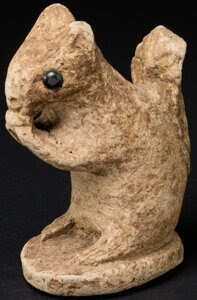 Which piece of Macerated Currency would you consider to be the rarest?
Which piece of Macerated Currency would you consider to be the rarest?
The rarest of the collectible items would have to be the large squirrel from Wade's collection, the two different posed rabbits, and the cross that I acquired. The cross is the only religious artifact from Macerated Currency, which makes for an interesting subject. The three cats posed on top of the capitol building is likely unique as well.
Are there pieces that were confirmed to have been created, but never discovered?
There are no listings or official records of what was made or how many of each example was created, so it is quite difficult to know and track what there was. When the squirrel turned up it was the first one anybody saw, the same goes for the "DIY" Macerated block. So, there may be more to surface over the course of time. There may be pieces out there that we are currently unaware of that will be "discoveries" upon their surface.
Are there any pieces that you or Wade were never able to locate?
 Yes, there is a handmade Robert E Lee bust that was made with Confederate Currency made by a POW. It is believed to be unique, and housed in Civil War museum in Fort Worth.
Yes, there is a handmade Robert E Lee bust that was made with Confederate Currency made by a POW. It is believed to be unique, and housed in Civil War museum in Fort Worth.
Do you have a favorite example out of all of the collection?
The William McKinley (LOT ID# 11008) would have to be among my favorite pieces, as it is considered modern, from the 1920s. The capitol building with the flag on top and drapes on the side has always stood out to me, even though it's a bit more common. The cross and bunny pieces are also among my favorites.
There are several items depicting US Presidents such as Teddy Roosevelt, Calvin Coolidge, and William McKinley (ID 11045, 11053, 11066). Do you know if any of these Presidents owned or had any interest in Macerated Currency?
No, I have never seen any pictures of historical figures with Macerated Currency. You have Truman who had his coin collection and JFK with his Swedish copper plate money, but never a US President with macerated currency. There was ever any mention of it with regard to any historical figures. Macerated was not very popular up until the 1940s.
Any advice or words to the new generation of collectors about collecting Macerated Currency?
Don't buy by price, buy by scarcity. Buy the unusual examples rather than accumulating common pieces such as shoes and hats. This is an exciting auction as there has never truly ever been a great Macerated Currency auction up until now.
DETECTORIST FINDS GILDED FRENCH COIN BROOCH
Coins have been made into jewelry and other useful objects for centuries. A metal detectorist recently uncovered a gilded brooch made with a French coin. -Editor
A man who has unearthed hundreds of artefacts in 40 years of metal-detecting says he dreams of finding "something that changes history".
His latest find, a gilded silver medieval brooch made from a French coin, has been declared treasure.
The detectorist discovered it quite close to home, having moved to Wymondham just before the first lockdown in 2020.
He knew the field's owner - who had given permission for the search - had planned to drill crops the next day, and an earlier find of a medieval lead pilgrim's ampulla - a container for holy water - suggested the field was promising.
"It didn't take long to find - I heard the signal, turned over the soil and there was this little glint of something, a brooch, a bit crumpled but in lovely condition," he said.
His most spectacular find so far is the medieval gold and sapphire Willingale Ring, now on display at Epping Forest District Museum, discovered in a field he had been searching for 18 years.
To read the complete article, see:
Metal detecting: 'I dream of a find that changes history'
(https://www.bbc.com/news/uk-england-norfolk-58001604)
GOLD COINS FOUND IN FRENCH HOME RENOVATION
Not all great coin finds require a metal detector. -Editor
 Hundreds of rare gold coins found in the walls of a remote French mansion go under the hammer this month, the auction house tasked with selling the treasure said on Thursday.
Hundreds of rare gold coins found in the walls of a remote French mansion go under the hammer this month, the auction house tasked with selling the treasure said on Thursday.
The 239 coins, minted before the French Revolution during the reigns of Louis XIII and Louis XIV, were discovered when the owners of the mansion near Quimper in the western Brittany region hired stonemasons to unite the three buildings of their property, auctioneers Ivoire said.
During the work, three craftspeople found a metal box filled with gold coins in a wall.
"The box was embedded in the wall, stuck between stones," the mansion's owner, Francois Mion, told AFP.
A few days later, they found more coins in a pouch hidden above a wooden beam, he said.
The 2019 find was only reported now after the owners tasked the auction house with selling the treasure.
The proceeds, estimated at 250,000 to 300,000 euros ($296,000-$355,000), will be divided between them and the craftspeople who found the coins.
The coins include several Louis d'Or and double Louis d'Or, including a very rare coin depicting Louis XIV dating back to 1646 -- it alone is valued at about 15,000 euros.
To read the complete article, see:
French home renovation yields rare gold coin treasure
(https://www.enca.com/news/french-home-renovation-yields-rare-gold-coin-treasure)
NEW YORK'S FIRST CURRENCY
Pablo Hoffman of New York City passed along this Gothamist article about New York's first currency. Thanks. -Editor
 William Bradford, New York’s first printer, arrived in the North American colonies in November 1685 at the age of 22. Settling initially in Pennsylvania, he established a printing shop in Oxford, near Philadelphia, where he plied his trade for the next seven years. After repeatedly running afoul of the Quaker authorities, however, he was invited by the Province of New York to come to the colony to establish its first public printing press. He arrived in Manhattan in 1693, opening his new business at what is now 81 Pearl Street (today, a bar and grill). His was the only press in New York until 1726, when his former apprentice, John Peter Zenger, established his own printing firm.
William Bradford, New York’s first printer, arrived in the North American colonies in November 1685 at the age of 22. Settling initially in Pennsylvania, he established a printing shop in Oxford, near Philadelphia, where he plied his trade for the next seven years. After repeatedly running afoul of the Quaker authorities, however, he was invited by the Province of New York to come to the colony to establish its first public printing press. He arrived in Manhattan in 1693, opening his new business at what is now 81 Pearl Street (today, a bar and grill). His was the only press in New York until 1726, when his former apprentice, John Peter Zenger, established his own printing firm.
During his long years in business, Bradford was responsible for many printing milestones in New York, including publishing the colony’s first book (1693), legal statutes (1694), newspaper (1725) and map (1731). The New York Public Library holds copies of all the aforementioned items, along with the first paper money circulated in the colony, indented bills dating from 1709, also printed by Bradford.
The term indented bill
derives from the stub cut from each note, which left an irregular, wavy edge. Provided it fit the corresponding stub kept on file by the government, such bills could be redeemed by the holder for coin in the amount of the stated denomination. New York was only the third colony to issue paper currency, following Massachusetts in 1690 and South Carolina in 1703.
Bradford’s indented bills can be viewed along with 250 other rare and unique items from the Library’s research collections as part of the Polonsky Exhibition of The New York Public Library’s Treasures. The free show (which requires no currency, just curiosity) opens Friday, September 24, 2021.
Bradford retired in 1744, at the age of 81, having worked in the printing trade for six decades. He died in 1752 and was laid to rest in the graveyard at Trinity Church. His legacy as a printer continued with the activities of his son Andrew and grandson William, both of whom enjoyed notable careers as printers during the 18th century. Today, Bradford is rightfully remembered as the pioneer printer of the Middle colonies.
This story is part of our partnership with the NYPL around the Polonsky Exhibition of The New York Public Library’s Treasures, which showcases items spanning 4,000 years from the Library's research collections. The objects and the stories behind them are meant to inspire, spark curiosity, and encourage deeper thinking about our history and world—we'll be publishing one NYC-related object a day throughout September, and you can see everything at gothamist.com/treasures.
To read the complete article, see:
This Is What NYC's First Currency Looked Like
(https://gothamist.com/arts-entertainment/nyc-first-currency)
S.W. CHUBBUCK AND THE BEETHOVEN EFFECT
The September 2021 issue of Nena News from the New England Numismatic Association has a nice article by C. John Ferreri on a topic we've discussed earlier - the interesting scrip notes issued by S.W. Chubbuck. With permission, we're republishing it here. Thanks! -Editor
S.W. Chubbuck was a manufacturer and dealer of telegraphic equipment in Utica, N.Y. Samuel F. B. Morse was the inventor of the code used in transmitting telegraphic messages. He also was a keen admirer of the music of Ludwig von Beethoven, especially the 5th Symphony. Like many other issuers of merchant scrip the Chubbuck company customized some of its notes to give them some personality of their own One of the notes Chubbuck issued actually had the Latin alphabet displayed and the equivalent code markers (Morse Alphabet) for each letter printed underneath. The note shown here was payable in U.S. Postage Currency (early issues of U.S. Fractional Currency). Mr. Chubbuck also issued copper tokens with the Morse Alphabet and Numerals showing.
The scrip shown above was printed and issued by this merchant for the reason of facilitating the making of change for
his customers in the Chubbuck store. During the first half of the 19th century there were times when hard money became
scarce due to economic hard times. People tended to hoard metallic
coins, especially silver and gold and not use them as was intended
and this hindered commerce. To fill the void many merchants and
municipalities actually issued their own small denomination paper
change
. There were few state laws setting standards or guidelines
regarding their distribution. For the most part that was okay and
instances of fraud were few. The merchants of the New England and
other eastern states were mostly careful and honest businessmen.
Most merchant scrip appeared as typeset and plain as can be paper notes issued in fractions of a dollar and redeemable in amounts equaling whole dollars. Often the merchant would have a design printed on these small bills denoting the type of business he was engaged in. A seller of sewing machines could have the image of a sewing machine; a shoe smith could have an image of a shoe or boot, etc. So, it came to be that Mr. Chubbuck the purveyor of telegraphic equipment had the Morse Code displayed on this issue of his scrip. The Morse code was the communication vehicle that was transmitted by telegraph. Maybe he thought he should be touting that fact by educating local residents who might not know.
Beethoven wrote his 5th Symphony 30 years before there was a
telegraph but Morse found a way to remember him within his code
markers. For the letter V
in his code he designated, the markers,
dit, dit, dit, dah
so every time a letter V
(the Roman equivalent
for the number 5
) was telegraphed, the code was translated into
the four coded sounds that were the opening of Beethoven’s 5th
Symphony! If you enunciate the four coded sounds you will hear
what I mean, the opening notes of the 5th Symphony! (So, who
thinks collecting obsolete paper money is boring?) Was this all a
coincidence or done by design? Unfortunately, S.F. B. Morse is not
available to give us the answer!
Many unusual anecdotes such as this come to light when collecting old paper money. To learn more about incidences like this visit the Currency Club of New England. It meets in Waltham once a month. Detailed information appears in the club listings toward the back of this booklet. Come visit with us! Tell us your story!
Chubbuck copper token images were taken from the Internet.
For more information on the New England Numismatic Association, see:
https://www.nenacoin.org/
To read earlier E-Sylum articles, see:
MORSE CODE ON MONEY
(https://www.coinbooks.org/esylum_v16n19a18.html)
NOTES FROM E-SYLUM READERS: MAY 19, 2013 : Morse Code on S.W. Chubbuck Tokens
(https://www.coinbooks.org/esylum_v16n20a12.html)
MORE ON S. W. CHUBBUCK
(https://www.coinbooks.org/esylum_v16n21a11.html)
SAMUEL WINCHESTER CHUBBUCK (1799-1875)
(https://www.coinbooks.org/v24/esylum_v24n07a18.html)
KA-CHING! THE ART OF ANN CARRINGTON
Ed Hohertz passed along this SPINK catalogue of works by artist Ann Carrington, many of which have numismatic themes. Thanks! -Editor
 From the Foreword by SPINK Chairman and CEO Olivier D. Stocker:
From the Foreword by SPINK Chairman and CEO Olivier D. Stocker:
"When I was first shown the images of Ann’s stamp and coin works, I immediately felt there was a symbiosis between Spink and her renditions of Machin’s stamp portraits and the Indian Head coin. On further investigation of some of Ann’s other works and discovering the intricate work involved and the materials employed, I was determined to hold this major exhibition at our 69 Southampton Row premises. This catalogue represents the body of Ann’s pieces to be included in the forthcoming exhibition."
To read the complete catalogue, see:
https://storage.spink.com/source/Docs/Ann_Carrington_SPINK_Catalogue.pdf
VIDEO: MONEY IS THE ONE TRUE GOD
Here's a great video animation using banknotes. Check it out. -Editor
Director and animator lachlan turczan has created a stunning video animation in collaboration with musician blake mills. titled ‘money is the one true god’, the six-minute-long music video has been made using imagery on banknotes from over 23 countries. The project takes viewers on a kaleidoscopic journey through the repeated motifs and iconic imagery on these bills, which reveal what humans have valued over time. The age of exploration leads to industrialization, wonders of the world are replaced by office buildings, and icons of freedom stand in stark contrast to images of slavery. The animation culminates with the collective eyes of all world leaders staring back at the audience.
‘Money is the one true god’ first began as a covid lockdown passion project. Lachlan turczan explains the process, ‘I made hi-resolution scans of banknotes from 23 countries around the world. I used machine learning to further enhance these scans so that I could zoom in on the intricacies of the engravings. using replacement animation techniques, the guilloché patterns wash over the viewer in a barrage of visual rhythms.’
Check out the video. It's a delightful, mesmerizing banknote collector's fever dream! Someone should project this on a wall at a coin or paper money show. -Editor
To watch the video on Vimeo, see:
Blake Mills | Money Is The One True God
(https://vimeo.com/587431283)
To read the complete article, see:
A KALEIDOSCOPIC JOURNEY THROUGH MONEY
(https://www.designboom.com/art/lachlan-turczan-animates-banknotes-money-is-the-one-true-god-09-03-2021/)
SALES OF THE CURRENCY BY DAMIEN HIRST
Here's a follow-up article looking at the aftermarket for Damien Hirst’s latest project, The Currency. J.S.G. Boggs would have loved this. -Editor
These two Damien Hirst ‘Currency’ works sold within a hour of each other. ‘5083. Yeah, come on for a ride’, left, sold for US$45,966. ‘6307. We shall bring our own children’, right, sold for US$26,285.
Hirst’s latest art project, called The Currency, comprises 10,000 A4 sized pieces of handmade paper covered in very similar but not identical coloured spots. The back of each is numbered and signed by the artist with an arty title. Like actual contemporary bank notes, each also has a watermark, a microdot and a hologram to make it hard to forge.
The interesting twist is that Hirst has made this into an interesting experiment in the highly irrational economics of collectibles and blockchain technology.
Each painting has a digital certificate of ownership — a so-called non-fungible token (NFT). In fact, the buyers of each work have paid US$2,000 for the electronic token only. If they want the physical artwork, they must choose by July 21 2022 to trade in their token. If they do so the token will be destroyed. If they decide to keep the token, the artwork will be destroyed. They cannot have both.
Adding to the fun is the secondary trade in the NFTs — highlighting just how much of the art market is driven by money rather than love. The sale of all 10,000 works is worth $US20 million. But over the past month, since the artworks went on sale, there have been more than 1,800 resales, for almost US$40 million. The highest price paid so far is US$120,000, for No. 6272, titled Yes
.
The original sale of the artworks worked like an initial public offering of shares. Aspiring buyers could register and say how many they wanted (but not nominate which individual work). The offering was over-subscribed, as more than 30,000 people wanted more than 60,000 tokens (that is, three time the available number).
This demand has spilled over into a secondary electronic marketplace (managed by HENI, the company that handled the initial sales). The graph below shows these sales.
Almost 500 are currently listed for sale. Most of the recent sales were for about US$50,000, more than 20 times the original asking price. What makes one work worth more than another? That’s hard to say, though titles appear to play a big part. Yes
, which exchanged hands for US$120,000, for example, is one of the few works with a one-word title.
I think the paintings are at least pretty. And there’s the option at least to swap the NFT into a physical form the owner can hang on their wall. There are enough people who would like to do that to give this artful currency
some underlying fundamental value.
That can’t be said of cryptocurrencies.
To read the complete article, see:
Damien Hirst’s dotty ‘currency’ art makes as much sense as Bitcoin
(https://theconversation.com/damien-hirsts-dotty-currency-art-makes-as-much-sense-as-bitcoin-166958)
To read earlier E-Sylum articles, see:
THE CURRENCY BY DAMIEN HIRST
(https://www.coinbooks.org/v24/esylum_v24n32a30.html)
ARTISTS USING MONEY AS A METAPHOR
(https://www.coinbooks.org/v23/esylum_v23n14a41.html)
THE BIG BUSINESS OF LIBRARY E-BOOKS
Bibliophiles may enjoy this New Yorker piece on the business model of library e-books. Is e-lending coming to numismatic literature? -Editor
 For the most part, publishers do not sell their e-books or audiobooks to libraries—they sell digital distribution rights to third-party venders, such as OverDrive, and people like Steve Potash sell lending rights to libraries. These rights often have an expiration date, and they make library e-books
For the most part, publishers do not sell their e-books or audiobooks to libraries—they sell digital distribution rights to third-party venders, such as OverDrive, and people like Steve Potash sell lending rights to libraries. These rights often have an expiration date, and they make library e-books a lot more expensive, in general, than print books,
Michelle Jeske, who oversees Denver’s public-library system, told me. Digital content gives publishers more power over prices, because it allows them to treat libraries differently than they treat other kinds of buyers. Last year, the Denver Public Library increased its digital checkouts by more than sixty per cent, to 2.3 million, and spent about a third of its collections budget on digital content, up from twenty per cent the year before.
There are a handful of popular e-book venders, including Bibliotheca, Hoopla, Axis 360, and the nonprofit Digital Public Library of America. But OverDrive is the largest. It is the company behind the popular app Libby, which, as the Apple App Store puts it, lets you log in to your local library to access ebooks, audiobooks, and magazines, all for the reasonable price of free.
The vast majority of OverDrive’s earnings come from markups on the digital content that it licenses to libraries and schools, which is to say that these earnings come largely from American taxes. As libraries and schools have transitioned to e-books, the company has skyrocketed in value. Rakuten, the maker of the Kobo e-reader, bought OverDrive for more than four hundred million dollars, in 2015.
he company that became OverDrive began, in the mid-eighties, as a document-digitizing firm, in a suburb of Cleveland. Potash and his wife, Loree, an academic librarian, had both gone to law school at night, and their early clients were law firms that needed help digitizing large volumes of paperwork. Eventually, Harcourt Brace Jovanovich (a precursor to Houghton Mifflin Harcourt) hired the young company to digitize reference books, and other publishers followed. It was probably about a ten-year struggle to get the e-book concept to grab hold,
Jon Nigbor, an early colleague and investor who left OverDrive around 1990 and sold his stake in 2010, told me. It was the twenty-five-year overnight-success story.
(Nigbor describes himself as a co-founder of the company; Potash denies this.)
In the two-thousands, OverDrive helped publishers set up online stores and sold e-books directly to consumers through its own marketplace. The company also persuaded a few presses to license their e-books to libraries. At the time, the six largest publishers tended to sell their goods through online retailers, such as Amazon, which released its e-reader, the Kindle, in 2007. But, gradually, the Big Six began to sell digital rights to libraries under a one copy, one user
model. As soon as one reader returned an e-book, a second reader could check it out, and so on, with no expiration date. At the beginning, we were really trying to replicate what happens on the print-book side,
a publishing executive told me. Digital books, which could in theory be duplicated for free by any librarian with a computer, would still have waiting lists.
We then saw the first wrinkle in one copy, one user,
Potash said. In 2011, HarperCollins introduced a new lending model that was capped at twenty-six checkouts, after which a library would need to purchase the book again. Publishers soon introduced other variations, from two-year licenses to copies that multiple readers could use at one time, which boosted their revenue and allowed libraries to buy different kinds of books in different ways. For a classic work, which readers were likely to check out steadily for years to come, a library might purchase a handful of expensive perpetual licenses. With a flashy best-seller, which could be expected to lose steam over time, the library might buy a large number of cheaper licenses that would expire relatively quickly.
Libraries now pay OverDrive and its peers for a wide range of digital services, from negotiating prices with publishers to managing an increasingly complex system of digital rights. During our video call, Potash showed me OverDrive’s e-book marketplace for librarians, which can sort titles by price, popularity, release date, language, topic, license type, and more. About fifty librarians work for OverDrive, Potash said, and each week they curate the best ways each community can maximize their taxpayers’ dollar.
The company offers rotating discounts and generates statistics that public libraries can use to project their future budgets. When I noted that OverDrive’s portal looked a bit like Amazon.com, Potash didn’t respond. Later, he said, with a touch of pride, This is like coming into the front door of Costco.
Alan Inouye, the senior public-policy director at the American Library Association, told me that consolidation could reduce competition and potentially drive the cost of library e-books even higher. OverDrive is already a very large presence in the market,
he said. The company’s private-equity owner, K.K.R., also owns a major audiobook producer, RBMedia, which sold its digital library assets to OverDrive last year.
To read the complete article, see:
The Surprisingly Big Business of Library E-books
(https://www.newyorker.com/news/annals-of-communications/an-app-called-libby-and-the-surprisingly-big-business-of-library-e-books)
THE BOOK BAZARRE
LOOSE CHANGE: SEPTEMBER 5, 2021
Here are some additional items in the media this week that may be of interest. -Editor
Aaron Oppenheim forwarded this YouTube video of conversations with young numismatists at recent ANA World's Fair of Money. Thanks. Lots of comments to read as well. -Editor
To watch the video, see:
The Future of the Coin Collecting Hobby - Conversations with Young Numismatists at ANA Coin Show
(https://www.youtube.com/watch?v=M_DTtZRUCnc)
This Coin Update article by Dave Bowers recounts the rollout of the Lincoln Cent in 1909. -Editor
In 1909 much enthusiasm was generated for the forthcoming cent by various newspapers. The Mint received requests galore from banks, businesses, and others who wanted to have a supply of the new cents on hand. To anticipate the demand, 25 million were struck before distribution began on August 2nd. The popularity proved so great that Sub-Treasury outlets and banks rationed the new cents to a limit of 100 per customer. Long lines formed at the payout windows of various Treasury Department outlets. On August 5th supplies ran out, and signs were posted reading, NO MORE LINCOLN PENNIES.
For the next few days newsboys, street sellers, and others had a field day selling the pieces at premiums. As usual in such instances, tales of scarcity helped fuel the demand. It was widely stated that there was a mistake in the design, and all the pieces would be recalled.
To read the complete article, see:
Bowers on Collecting: 1909 introduction of the Lincoln cent generated public enthusiasm
(http://news.coinupdate.com/bowers-on-collecting-1909-introduction-of-the-lincoln-cent-generated-public-enthusiasm/)
This article from the Philippines describes how termites ate a man's life savings. -Editor
Adonis Buemia delivered ice for a living for three decades.
In the course of this time, the 70-year-old was able to save enough to buy a house, a brand new tricycle, and even set aside almost P50,000 in cash from his daily income of P300.
Each day, he saved P100 from his takehome pay and tucked it away inside a cabinet in his home.
To his dismay, the solo parent and a primary caregiver to a special child later discovered that his cash stash literally disintegrated inside their hiding place the cabinet after termites feasted on them.
Desperate to save his hard-earned cash, Buemia commented on the Facebook account of a program in a local TV station for help. In turn, the program referred his case to the BSP.
In a statement, the Bangko Sentral ng Pilipinas’ Currency Policy and Integrity Department (CPID) immediately pre-evaluated what was left of the termite-infested bills.
To read the complete article, see:
BSP replaces man’s termite-damaged peso bills worth P50,000
(https://business.inquirer.net/329578/bsp-replaces-mans-termite-damaged-peso-bills-worth-p50000)
FEATURED WEB SITE: HOMETOWN CURRENCY
This week's Featured Web Site is the Hometown Currency Virtual Museum. Found via News & Notes from the Society of Paper Money Collectors (Volume VII, Number 7, August 3, 2021).
Hometown Currency explores the history of Florida Currency in a museum and research role breaking down currency by city and by bank. It also provides great reference to news articles, historical pictures, and intuitive videos for users of all ages to learn and enjoy.




